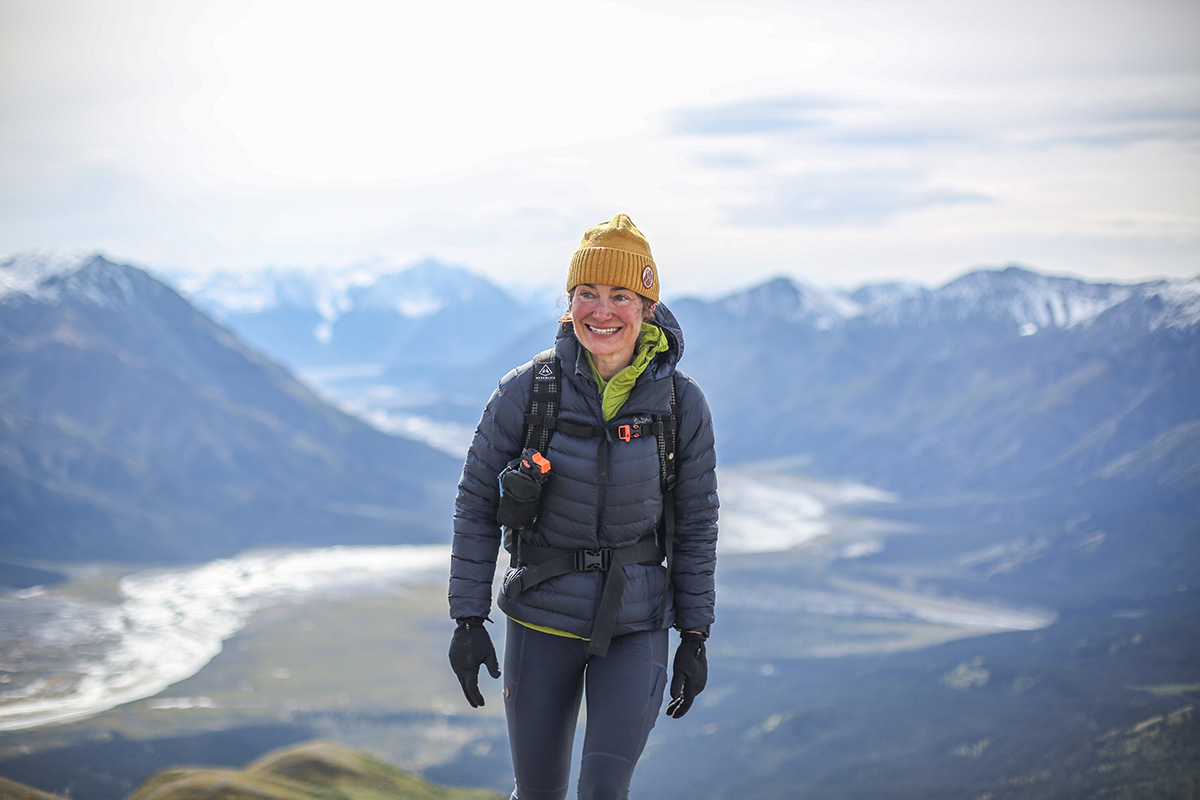
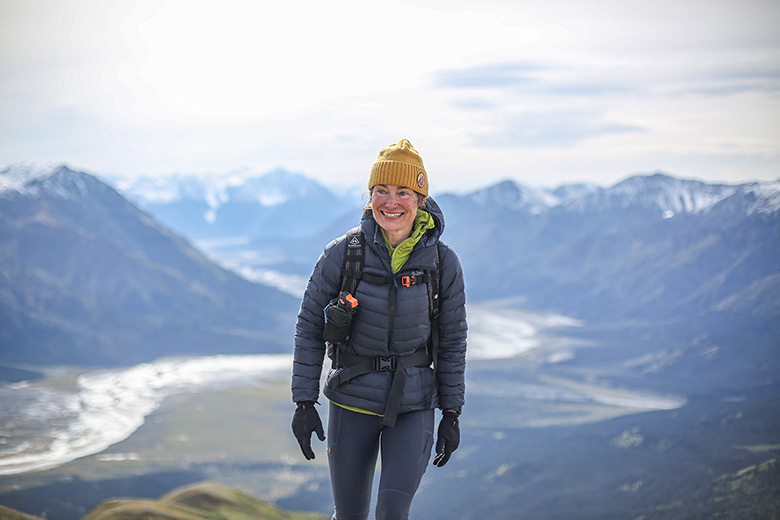
As impressively warm and cozy insulators, down jackets are one of our favorite pieces of outdoor gear. Whether you’re looking for an uber-light alpine piece for the mountains, a casual and well-tailored option for around-town use, or something in between, there’s a down jacket that fits the bill. Switchback Travel’s female editorial staff hit the slopes, trails, and city streets to compile this list, which ranges from technical, performance-oriented jackets to casual everyday designs. Below are our picks for the best women's down jackets of 2025. For more information, see our women's down jacket comparison table and buying advice below the picks, along with details about our testing process.
Editor's note: We updated this guide on April 22, 2025, to remove some discontinued products and to change our top recommendation from the Patagonia Down Sweater Jacket to the Down Sweater Hoody. We also added some new photos from testing and swept the guide for accuracy across all links, specs, and colorways.
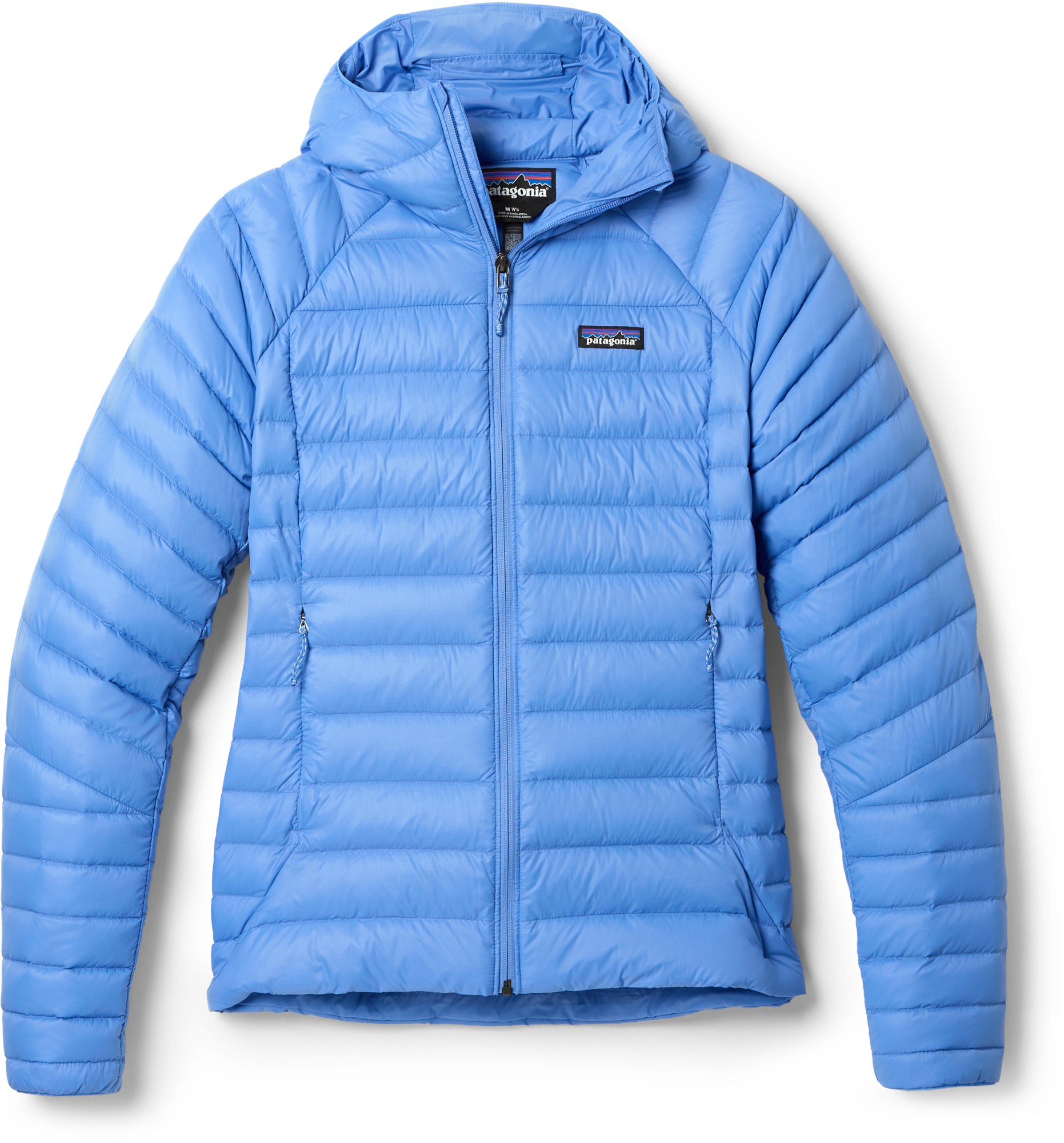 Category: Lightweight
Category: Lightweight
Weight: 12.1 oz.
Fill: 4.0 oz. of 800-fill down
What we like: Impressive versatility; made with a recycled shell and ethically sourced down.
What we don't: Pricey for the level of warmth; minimal water resistance.
Some down jackets are unmistakably casual, while others are designed specifically for the backcountry. But if you’re looking for one jacket that can do it all, the Patagonia Down Sweater Hoody is perhaps the most versatile option on the market. Like some of the more specialized picks below, the Down Sweater is light enough to pack on your next hiking trip yet warm and streamlined enough to layer under a shell for skiing. And with Patagonia's premium build quality and finish and a variety of fresh colorways, it doesn’t look overly technical for walking around town or grabbing a drink after a long day in the mountains.
The Down Sweater was redesigned a couple years ago, adding a NetPlus shell that’s made from recycled fishing nets, warmth features like larger side baffles and a more structured collar, and drop-in pockets for additional storage. Patagonia also managed to lower the weight over older versions, making the current iteration of the Down Sweater Hoody the most versatile it's ever been and giving performance-minded designs like the Arc'teryx Cerium below a run for their money in terms of warmth-to-weight ratio. We’ve been wearing the updated design for two years now and are huge fans of its flattering fit and soft, sleeping-bag-like construction. For those who want added coverage, the Down Sweater also comes in a non-hooded version that weighs just 10.3 ounces and will save you $50.
Read more: Patagonia Down Sweater Hoody review
See the Patagonia Down Sweater
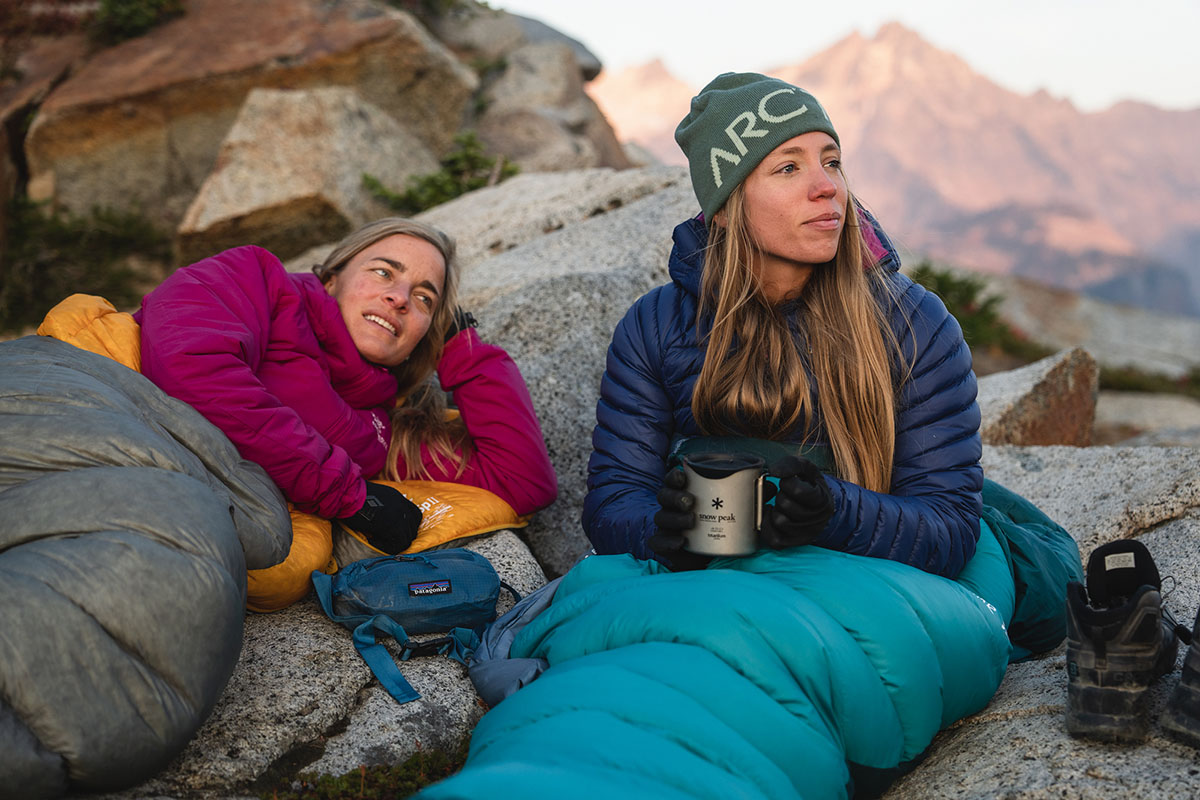
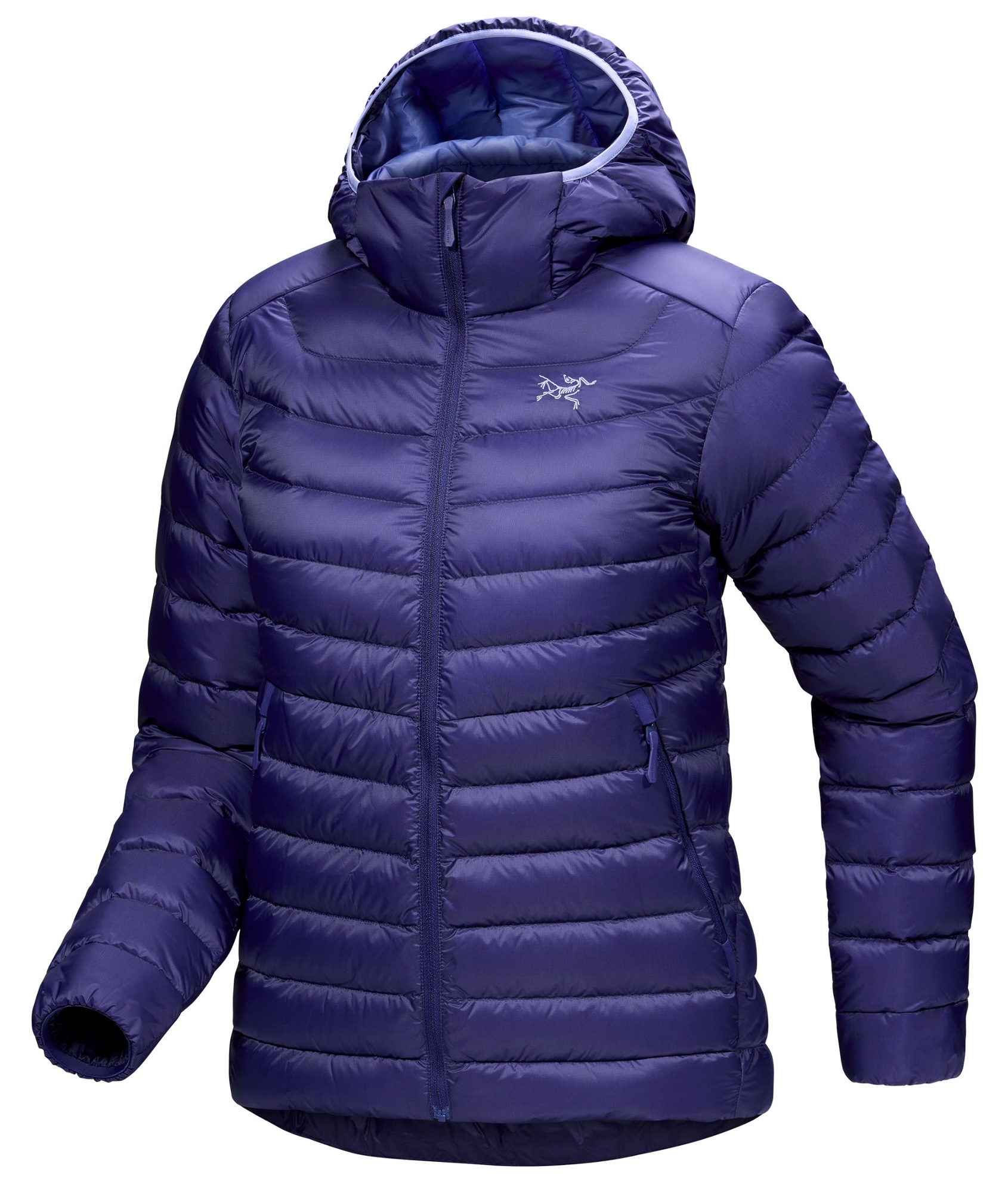 Category: Lightweight
Category: Lightweight
Weight: 10.2 oz.
Fill: 3.2 oz. of 850-fill down & 80/100g Coreloft
What we like: Great warmth and weather protection in a 10-ounce package.
What we don’t: Pricey and not super durable.
The Patagonia Down Sweater Hoody above is a great pick for everyday and light performance use, but you’ll want a more purpose-built piece for serious days out. Arc’teryx’s Cerium Hoody is the definition of a performance down jacket, combining high-fill-power down, a thin shell fabric, a svelte fit that maximizes mobility with minimal bulk, and a simple yet functional feature set. With a total weight of 10.2 ounces, it can stuff away into a corner of your backpack or the included stuff sack, but when deployed, the 850-fill down packs an impressive punch. Importantly, Arc’teryx also added synthetic Coreloft insulation in areas most prone to getting wet, including the shoulders, underarms, cuffs, and collar. All told, for backcountry skiers, backpackers, climbers, and other weight-conscious adventurers, the Cerium Hoody is one of the best-equipped options on the market.
While we love the Cerium Hoody for days that venture far from the car, it doesn’t cross over particularly well for daily wear. First, the 15-denier face fabric is decidedly thin and will need to be treated with care to avoid snags and tears, although our jacket has held up flawlessly thus far in testing. Additionally, the trim fit may be a bit restrictive depending on your layering preferences, but we found it to be spot-on in our usual size, with a low-profile but accommodating shape that worked well (and looked great) with a variety of layering combinations. Finally, at $400, you might be paying for a whole lot of premium tech that you don’t really need. But serious backcountry-goers will benefit from the top-notch warmth-to-weight ratio and added wet-weather assurance.
Read more: Arc'teryx Cerium Hoody review
See the Arc'teryx Cerium Hoody
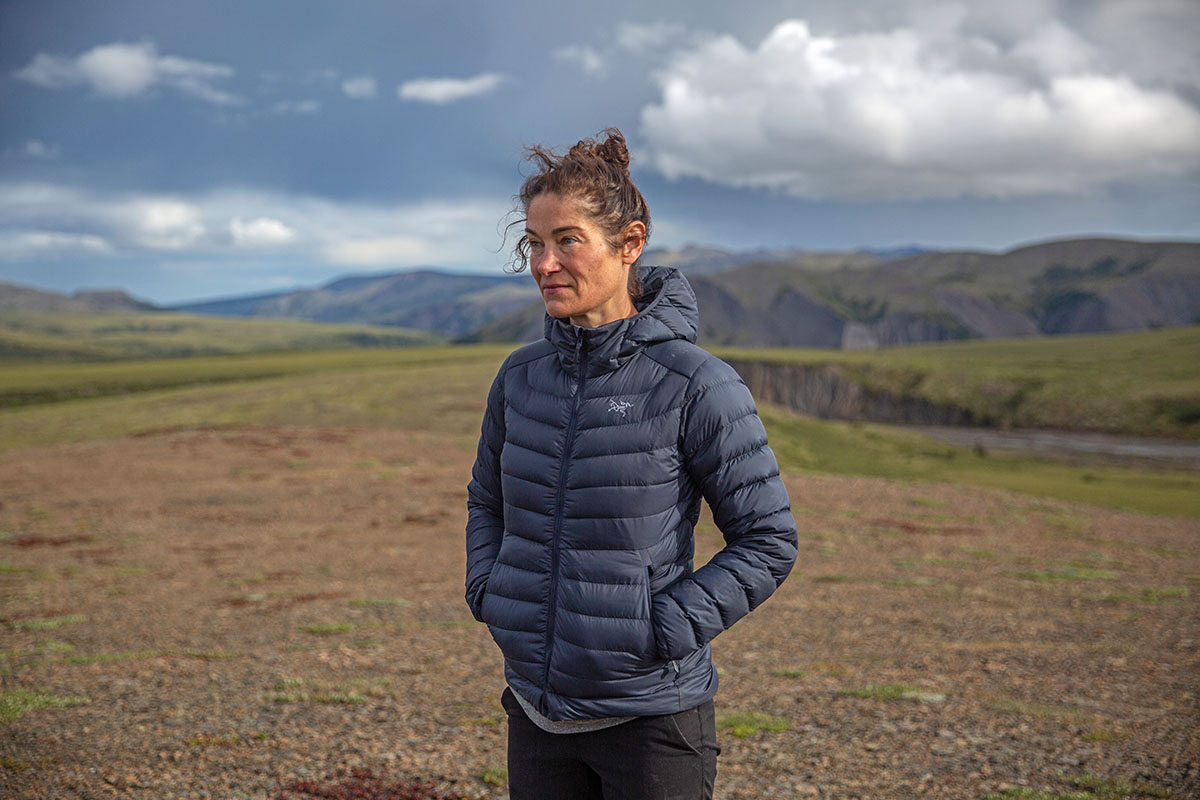
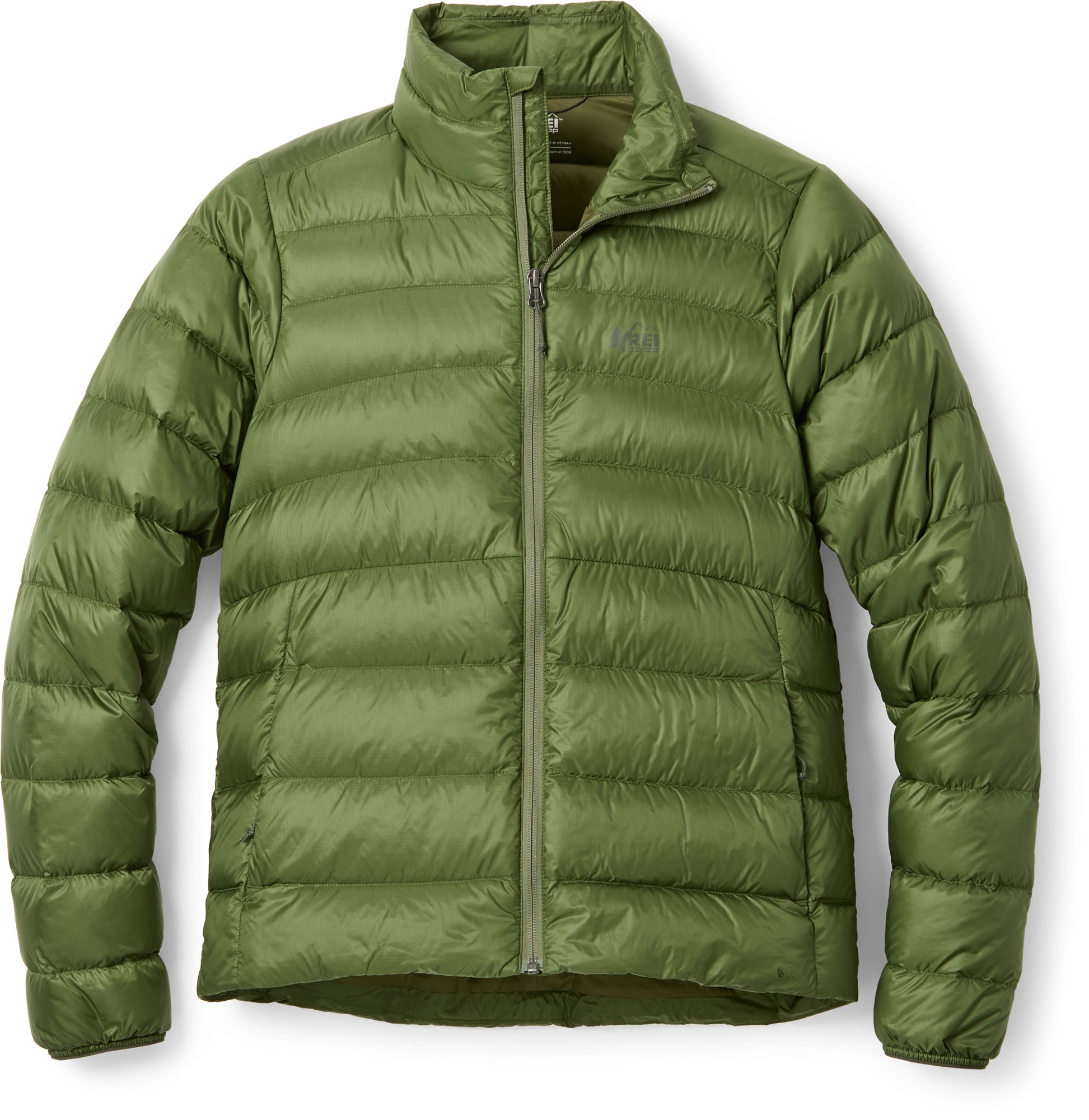 Category: Lightweight
Category: Lightweight
Weight: 10.2 oz.
Fill: 3.3 oz. of 650-fill down
What we like: Considerably cheaper than any other jacket on this list, yet surprisingly well built.
What we don’t: Not warm enough for true winter use.
The majority of down jackets on this list hover between $250 and $400, but REI’s 650 costs a fraction of that at just $129 (and often less on sale). Despite the low price point, it's still a well-rounded piece with 3.3 ounces of 650-fill down, a wind- and water-resistant shell, and a reasonably light weight. And with the last update, REI honed the design by adding a hem adjustment, a more durable ripstop nylon shell, and traditional horizontal baffles (the previous version had box baffles). The price went up when those changes were made, but the 650 Down is still a great budget choice for everything from daily use to hiking and resort skiing.
Keep in mind that although the REI 650 Down Jacket stuffs into its hand pocket, the 650-fill-power down isn’t as lofty or compressible as more premium models that hit 800-fill-power or higher. Because of this, the 650 suffers in the warmth-to-weight department compared to the pricier options here For example, the Arc'teryx Cerium above is much warmer and weighs the same even with the inclusion of a hood—REI doesn’t offer the 650 Down in a hooded version. But like many modernized jackets, the 650 uses a recycled nylon shell and RDS-certified down, which adds to the overall appeal. For a functional down jacket at a great price, the REI 650 Down Jacket is tough to beat. And for a step up in warmth, we also like REI’s Magma 850, which comes in both hooded ($249; 10.5 oz.) and non-hooded versions ($239; 9.2 oz.), features loftier and more compressible 850-fill down with a hydrophobic treatment for added moisture resistance.
Read more: REI Co-op 650 Down Jacket review (men's version)
See the REI Co-op 650 Down Jacket
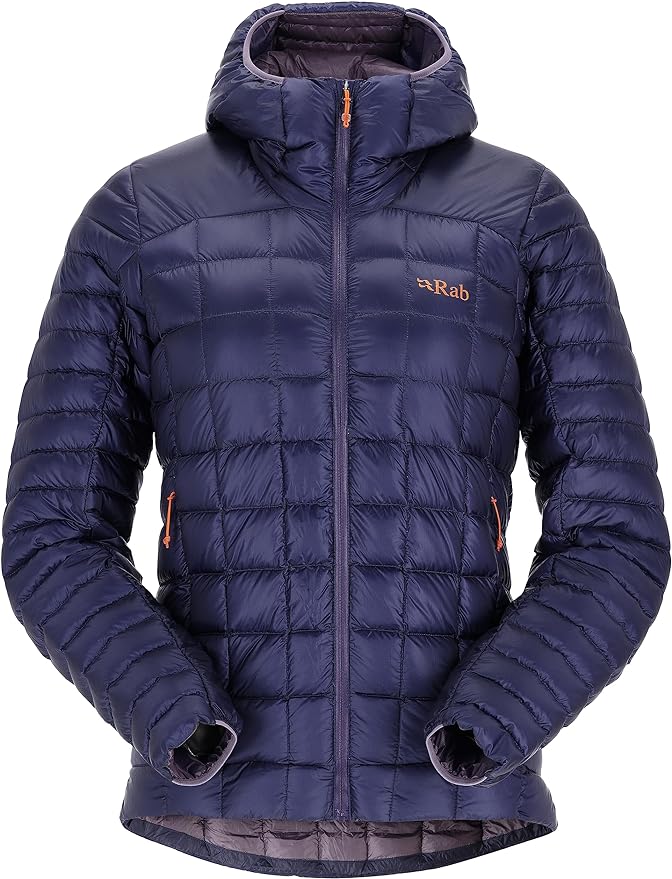 Category: Ultralight
Category: Ultralight
Weight: 8.0 oz.
Fill: 2.1 oz. of 900-fill down & PrimaLoft Gold
What we like: Great price for a very premium ultralight jacket.
What we don’t: Thin shell is too fragile for everyday use.
Rab’s Mythic Alpine Light is a relatively new entry on our list, beating out the Mountain Hardwear Ghost Whisperer (below) as our top-ranked ultralight pick. We haven’t stopped singing the jacket’s praises since we first tested it. It’s incredibly premium considering the price point, touting 900-fill down and PrimaLoft Gold insulation along with a protective and durable Pertex Quantum shell. And at just 8 ounces, it’s an excellent option for those looking to maximize warmth for weight. But the Mythic Alpine Light is not all function: It’s also a great-looking piece with boxed baffles and a few classy colorways, and we love the flattering length that offers a bit of extra coverage down the back.
If you’re considering the Cerium Hoody above, don’t overlook the Mythic Alpine Light here. It's a couple ounces lighter and features more premium down (900 vs. 850-fill-power)—all for a full $70 less. What’s more, it’s almost 3 inches longer than the Arc’teryx, which we love for standalone use but might cause the Mythic to peek out from underneath the hem of a rain jacket or hardshell. You also get a bit more warmth with the Cerium, and its marginally thicker shell (15 vs. 10D) make it the more durable offering. But as a slightly more minimalist option (both in terms of weight and price), the Rab is well worth a closer look. For those who want a bit more warmth, Rab also makes the standard Mythic Alpine, which features more than double the down for just 2 ounces and $60 more. And for the ultimate in loft and compressibility, Rab’s Mythic G packs in 4 ounces of ultra-lofty, 1,000-fill down but is even thinner with a 7D shell and costs a whopping $525.
See the Rab Mythic Alpine Light Down Jacket
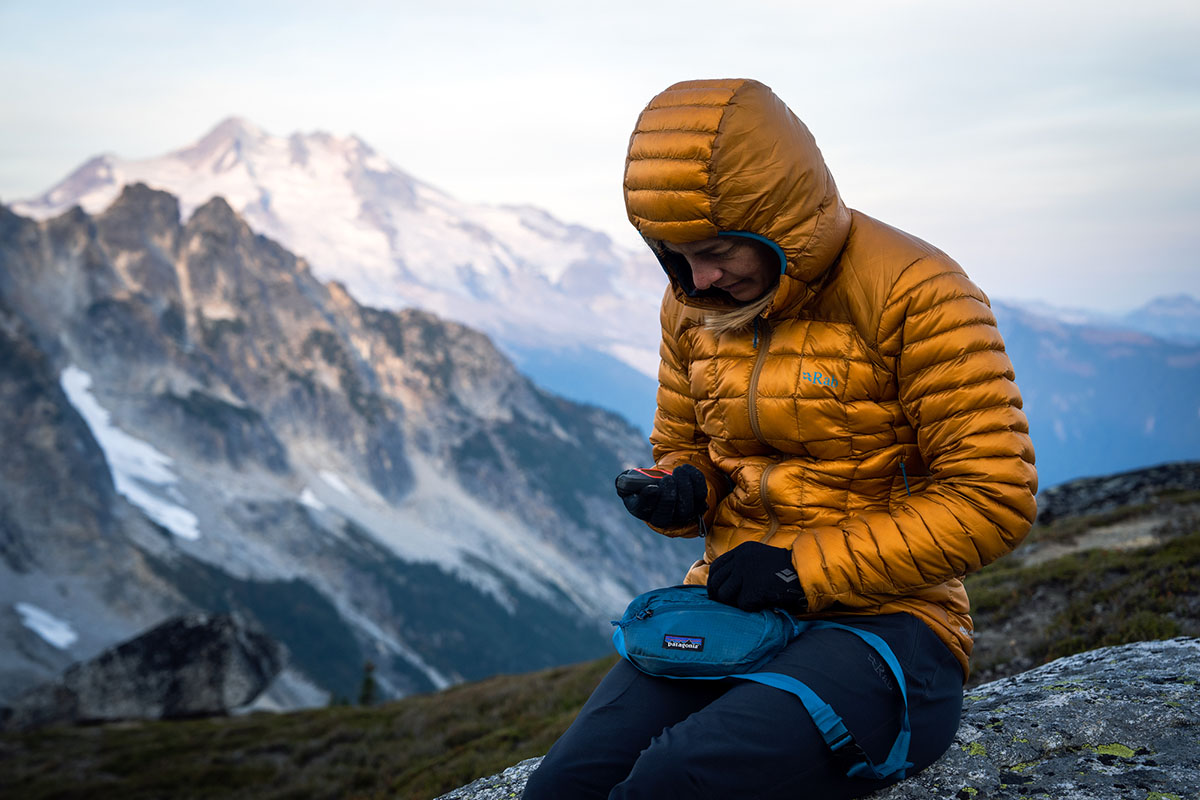
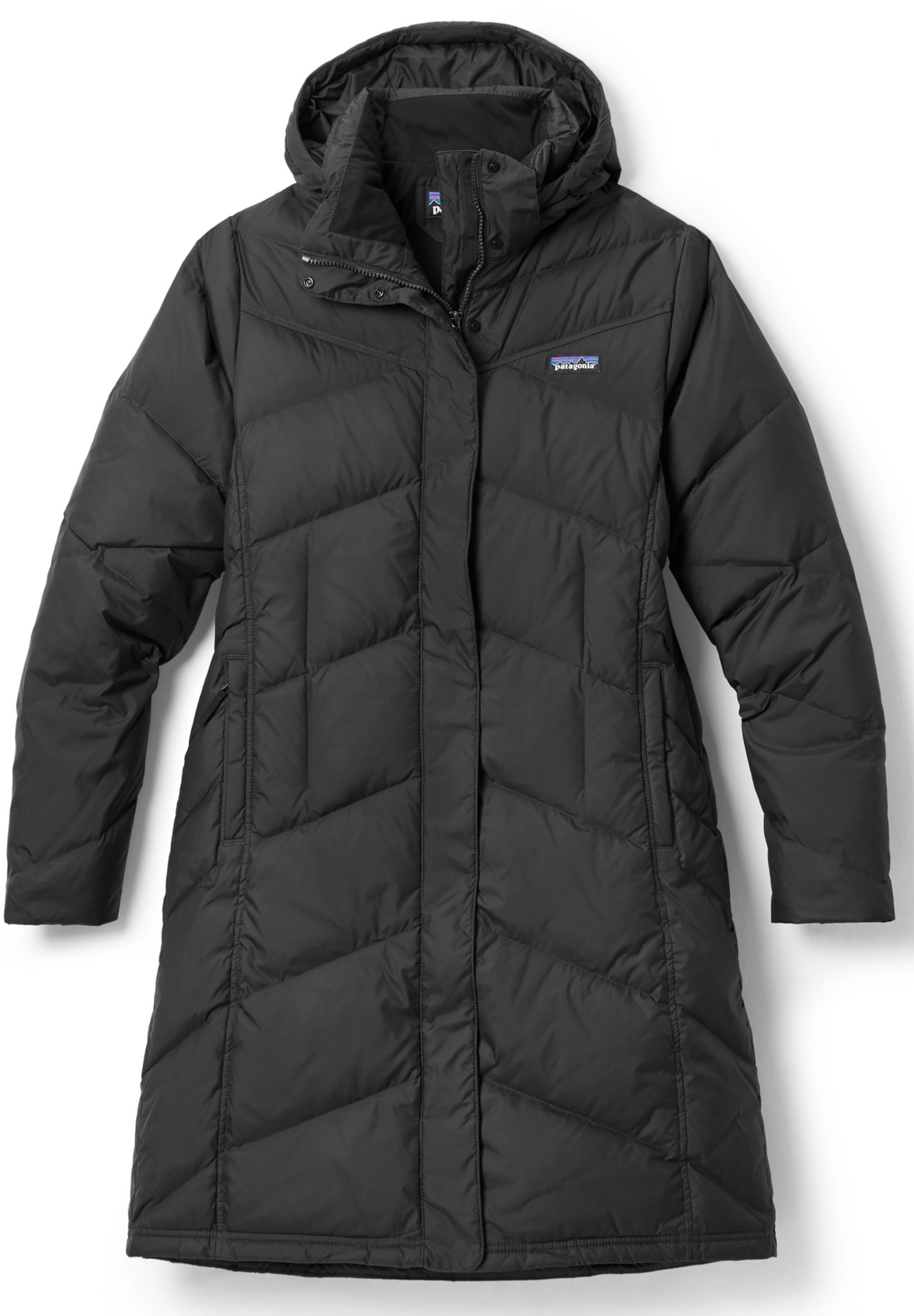 Category: Midweight
Category: Midweight
Weight: 2 lb. 5.0 oz.
Fill: 8.3 oz. of 600-fill down
What we like: Great styling and a major boost in warmth over shorter down jackets.
What we don’t: Bulky packed size; not everyone will like the length.
Down is the best insulator for weight-conscious mountain activities, but it’s also an ideal way to stay warm around town. For a high-quality option that doesn’t skimp on style, the Patagonia Down With It is our favorite women's down parka. You get a healthy 8.3 ounces of 600-fill down, a DWR finish for repelling light moisture (which is PFAS-free in the latest version), and cozy features like a fleece-lined collar and pockets. Further, the Down With It earns major style points with its chevron baffles and princess seams, removable hood, and a pair of snaps along each side that ensure you can wear it while seated without pesky bunching (most parkas don’t have this feature, and it’s a good one).
The big difference between the Down With It Parka and the options above is length, and not everyone will want the knee-length coverage and bulk. Some parkas, like Marmot's Montreal below, are classified as thigh-length rather than knee-length, but the added inches here (the Patagonia’s center back length is 35 in.) are especially nice in cold climates like the Midwest or Northeast. And while the Down With It doesn’t compress well for travel, it’s got one big thing going for it: warmth. 600-fill isn’t as light and compressible as higher-fill-power down, but this is less of a concern for casual use, and 8.3 ounces is a generous supply. For warmer conditions, the Down With It is available in a hip-length version, which packs in 7.1 ounces of 600-fill down and is more affordably priced at $229.
Read more: Patagonia Down With It Parka review
See the Patagonia Down With It Parka
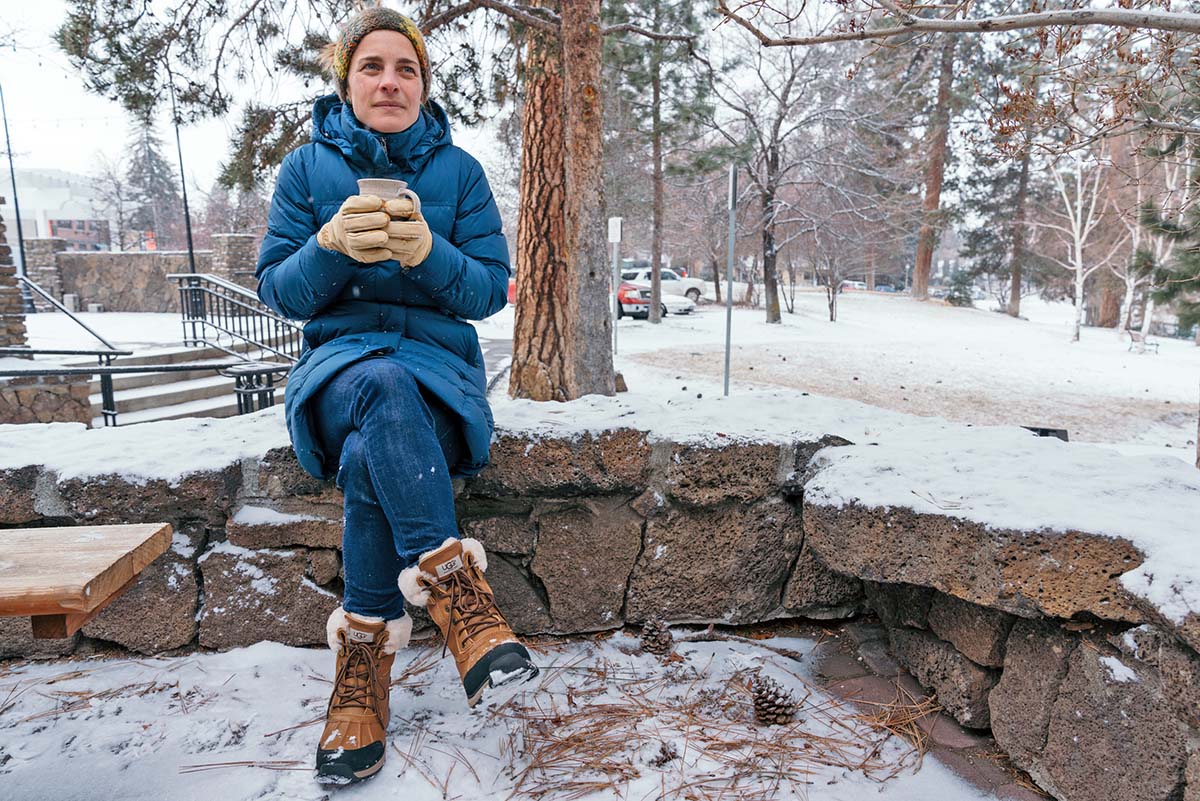
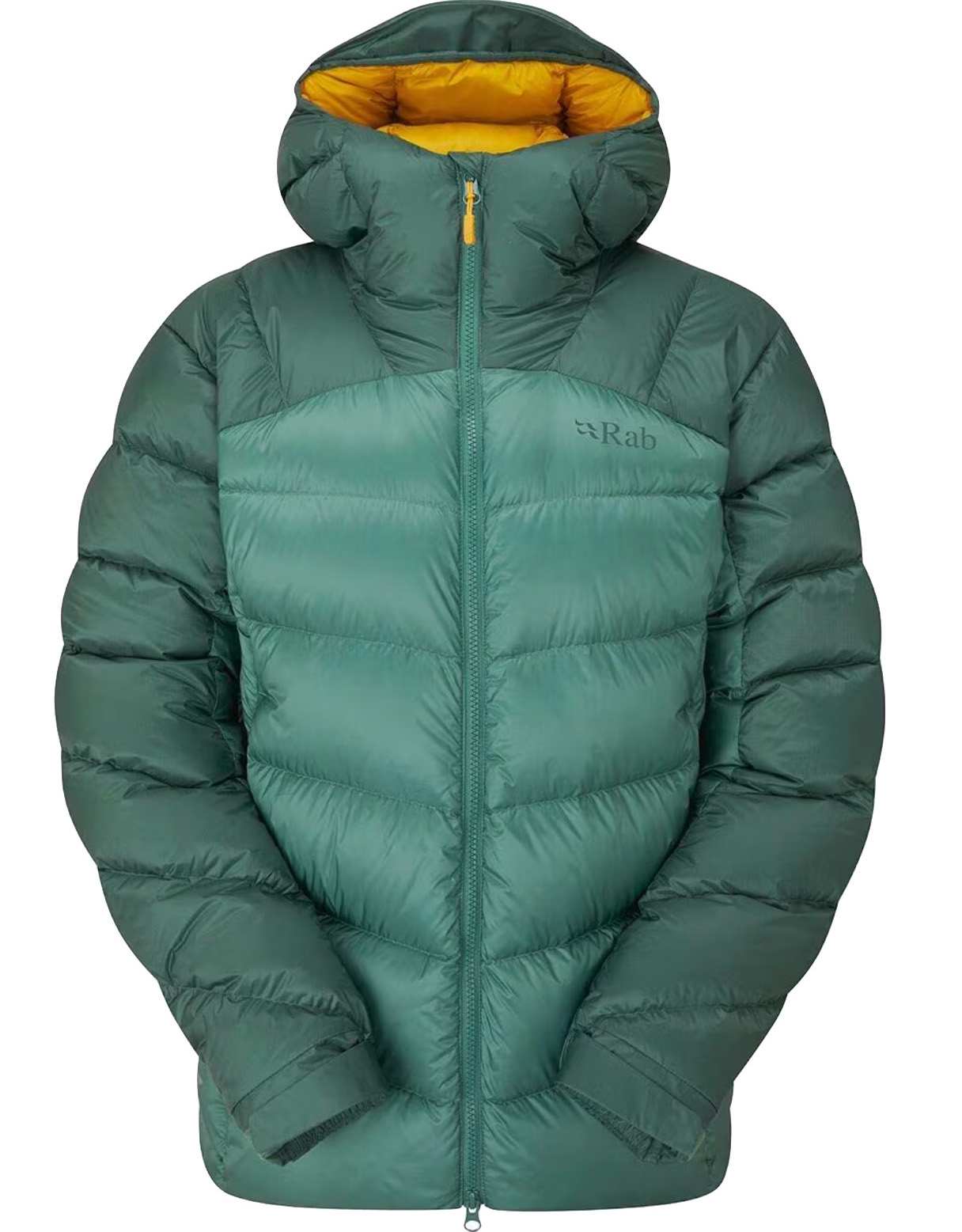 Category: Heavyweight
Category: Heavyweight
Weight: 1 lb. 1.7 oz.
Fill: 7.5 oz. of 800-fill down
What we like: Loaded with premium down.
What we don’t: Heavy and the left-hand zip can take some getting used to.
U.K.-based Rab is among our favorite outdoor clothing brands, and the Neutrino Pro is their beloved down jacket for cold-weather climbing and mountaineering. The last update added a water-resistant Pertex Quantum Pro shell but retained everything else that made it a classic. Most importantly, it packs in a ton of down—7 ounces of 800-fill hydrophobic down, to be exact—at roughly the same price as less-insulative options from Arc’teryx, Patagonia, and Mountain Hardwear. Further, the 20-denier shell has a quality feel and offers surprisingly good abrasion resistance. Even at $400, that’s a lot of bang for your buck.
What are the downsides of the Neutrino Pro? The first is the total weight at 1 pound 1.7 ounces, which is reasonable for serious winter use but too heavy for shoulder-season conditions. Second, Americans may have problems with the European-style left-hand zipper, which can take a while to get used to. Finally, the Neutrino Pro is overkill for all but the coldest days and therefore isn't as versatile as midweight options like the OR Coldfront below. These issues aside, the Rab is an exceptionally warm and comfortable winter piece at a good price. For an even warmer yet lighter jacket, check out Rab’s impressive Mythic Ultra Down ($495), which uses 900-fill-power down and a 10-denier Pertex Quantum (no “Pro”) shell.
Read more: Rab Neutrino Pro review (prior men's version)
See the Rab Neutrino Pro
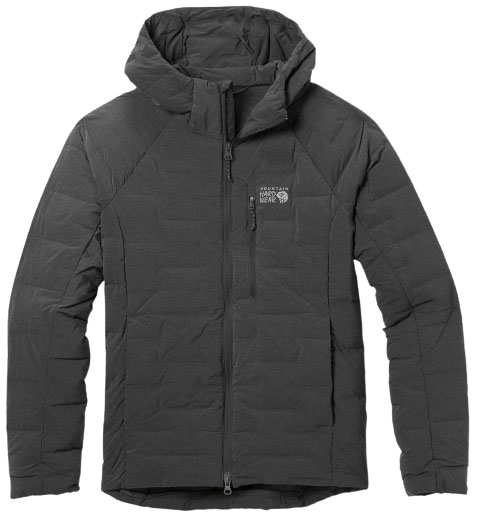 Category: Lightweight
Category: Lightweight
Weight: 15.5 oz.
Fill: 3.3 oz. of 700-fill down
What we like: Soft, stretchy, and durable face fabric.
What we don’t: Not equipped for wet weather and shorter cut than much of the competition.
The Stretchdown line is newer to Mountain Hardwear's offerings and is defined by its softness, stretchiness (hence the name), and welded seams (as opposed to stitched baffles). The idea behind the approach is to bring together the insulation of down with the mobility, comfort, and durability of a softshell jacket. Mountain Hardwear executed this well: The knit fabric of the Stretchdown Hoody is notably rugged, and the stretch brings a plushness to the feel that down jackets typically lack. Add to that a clean and understated style, and the Stretchdown is both a practical and good-looking everyday choice.
The Mountain Hardwear Stretchdown has some drawbacks, though. It's a bit heavy and bulky for the warmth it provides, and the 700-fill-power down isn't as lofty or compressible as other options on this list. While we love the soft outer fabric, it stains more easily, and $300 for a more casual piece feels a bit spendy (although overall quality is up to snuff). You can commit to casual and save a bunch of money with a design like the $129 REI 650 Down above, or pay just a little extra and get a warmer performance piece like the Himali Accelerator ($330) below. Still, the Stretchdown is a standout in terms of comfort and durability, and we receive compliments on the jacket's appearance quite frequently.
See the Mountain Hardwear Stretchdown Hoody
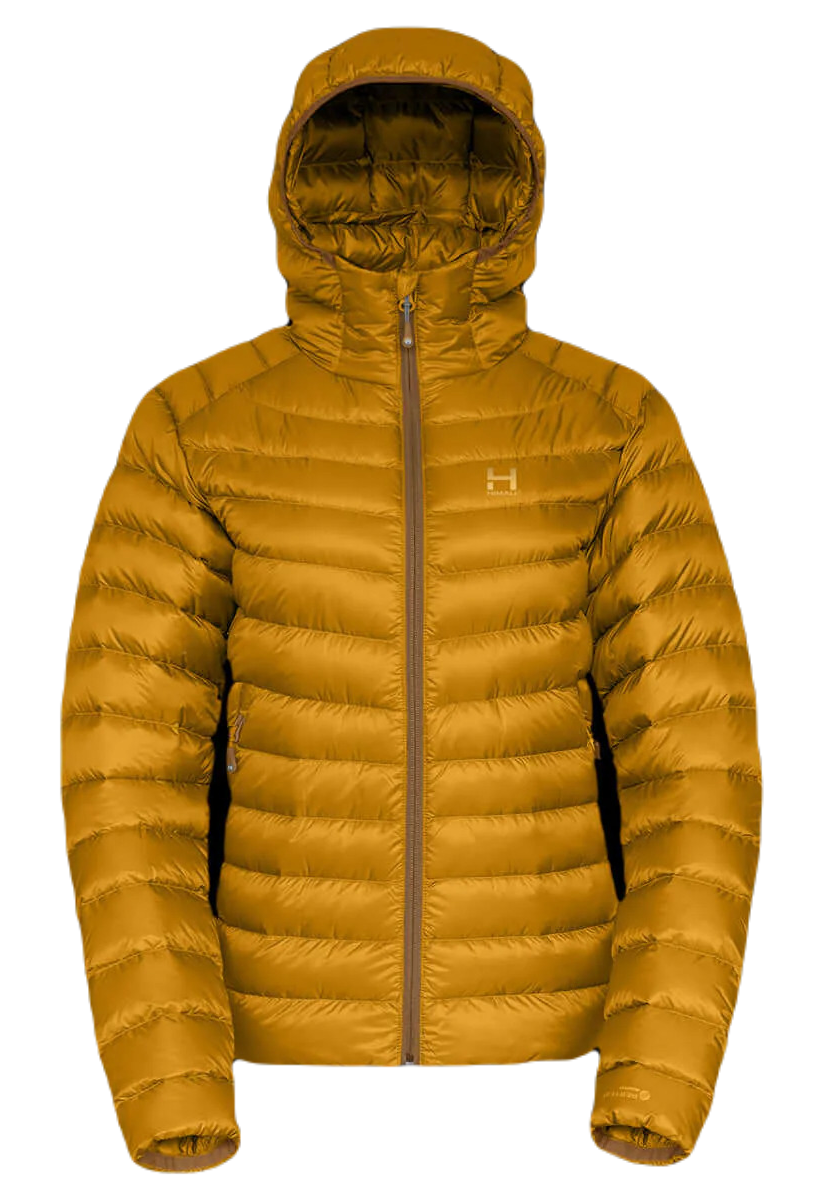 Category: Lightweight
Category: Lightweight
Weight: 11.0 oz.
Fill: 4.0 oz. of 850-fill down & synthetic
What we like: Arc'teryx-like fit and feel at a more approachable price point.
What we don’t: Cuff design isn't our favorite; not as widely available as many competitors.
Himali might lack the name recognition of brands like Arc’teryx and Patagonia, but make no mistake: This Colorado-based brand specializes in premium performance pieces at hard-to-beat prices. Their Accelerator Down Jacket is a case in point, combining a healthy 4 ounces of lofty and compressible 850-fill down (bonus: It's hydrophobic) with all the technical features we look for in a backcountry-ready design. These include a water-resistant shell and zippers, synthetic fill in moisture-prone areas, hood and hem drawcords, and a trim but not restrictive fit. When we first donned the jacket on a recent trip to Patagonia, we were immediately struck by its high-end feel that’s reminiscent of Arc’teryx’s $70-pricier Cerium Hoody above.
In addition to costing less than the Cerium, the Himali Accelerator is slightly warmer with an additional 0.8 ounces of down. It’s also more weather-resistant thanks to the Pertex Quantum shell, although neither jacket will be able to withstand heavy and sustained rainfall. And we did have a couple nitpicks with the Accelerator’s cuff design: Since the elastic is tucked inside, some of the shell fabric is exposed at the wrists, which led to premature stains and packing out. This was particularly noticeable in the Golden Hour colorway that we tested, although the darker designs likely won’t show wear as readily—and we confirmed with Himali that the cuffs will be redesigned for the next update. For many, the bigger issue will be availability: Himali gear is only sold through a few retailers, and you likely won’t have the chance to try the jacket on before buying. But we’ve had nothing but positive experiences with their customer service team, and performance for the price is truly exceptional.
See the Himali Accelerator
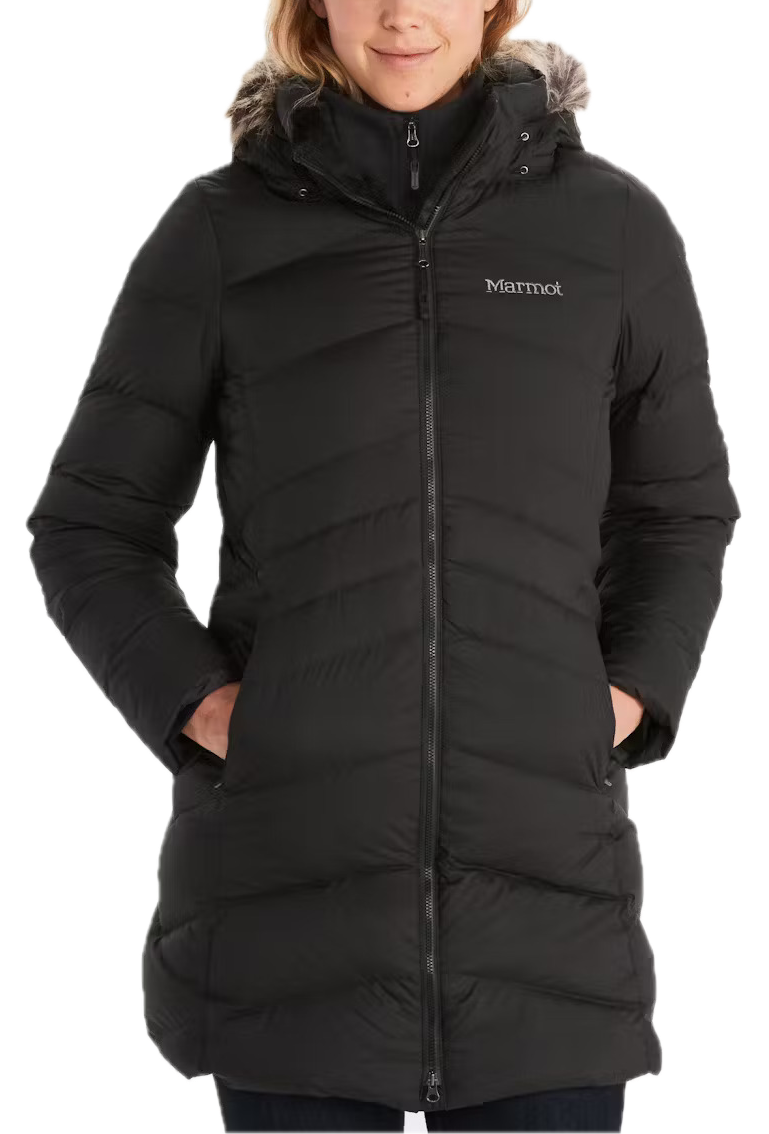 Category: Midweight
Category: Midweight
Weight: 2 lb. 0 oz.
Fill: 700-fill down
What we like: Mid-thigh length and soft liner.
What we don’t: Fits small and some might prefer a longer cut.
Casual down jackets come in all shapes and sizes, but we love the extra warmth and coverage that a parka provides. Marmot’s Montreal checks all of the important boxes with 700-fill down, good freedom of movement, and a super cozy hood with a removable faux fur liner. The inside of the jacket has a fleece liner that is noticeably soft to the touch, and the outside has a DWR treatment to help with light precipitation. Add in clean lines and some classy colorways, and the Montreal is a great all-around parka for the cold at a reasonable price point.
Keep in mind that the Marmot Montreal's thigh-length cut is a little shorter than competitors like the Patagonia Down With It Parka, which translates to less protection and warmth (but a more playful style). And in our experience, the Montreal is slightly less insulated and not suited for temperatures much below freezing without layers underneath. In terms of the all-important fit factor, we found that the jacket runs slightly small and would recommend sizing up if you're in between sizes or plan on layering. But if you can get the fit dialed, the Montreal is a winner.
Read more: Marmot Montreal Coat review (prior version)
See the Marmot Montreal Coat
 Category: Midweight
Category: Midweight
Weight: 1 lb. 5.2 oz.
Fill: 5.6 oz. of 700-fill-power down & 150g VerticalX Eco
What we like: Comfy, classy, and well priced for what you get.
What we don’t: Doesn’t pack down nearly as small as more premium options.
We're often impressed by the quality of Outdoor Research products, especially considering the price, and the Coldfront Down Hoodie is a perfect example of that. It's an excellent down jacket for just $279 that barely lags behind some of our more premium picks. Upon donning it for the first time, we were struck by the cozy loft from the mix of 700-fill down and synthetic VerticalX Eco insulation (the latter of which bodes well for weather resistance). The shell itself is durable yet soft, and we love the thoughtful extras like cuff gaiters with thumb loops, fleece-lined hand pockets, and tasteful branding. If you don't need a super technical jacket and would rather have something well-rounded for everyday wear or casual winter adventures, the Coldfront is a great option.
How does the OR Coldfront stack up to the picks above? It’s warmer than lightweight options like the Patagonia Down Sweater and Arc’teryx Cerium but falls short of a heavyweight like Rab’s Neutrino Pro for truly frigid conditions. It’s also on the heavier side for performance use and lacks the Neutrino's weather-ready shell and hydrophobic down, which go a long way in boosting protection on particularly wet adventures. Finally, the Coldfront doesn’t pack down as small as the higher-fill-power options above and below. But considering the price and warmth, it’s all most folks will need in a down jacket.
See the Outdoor Research Coldfront Down Hoodie
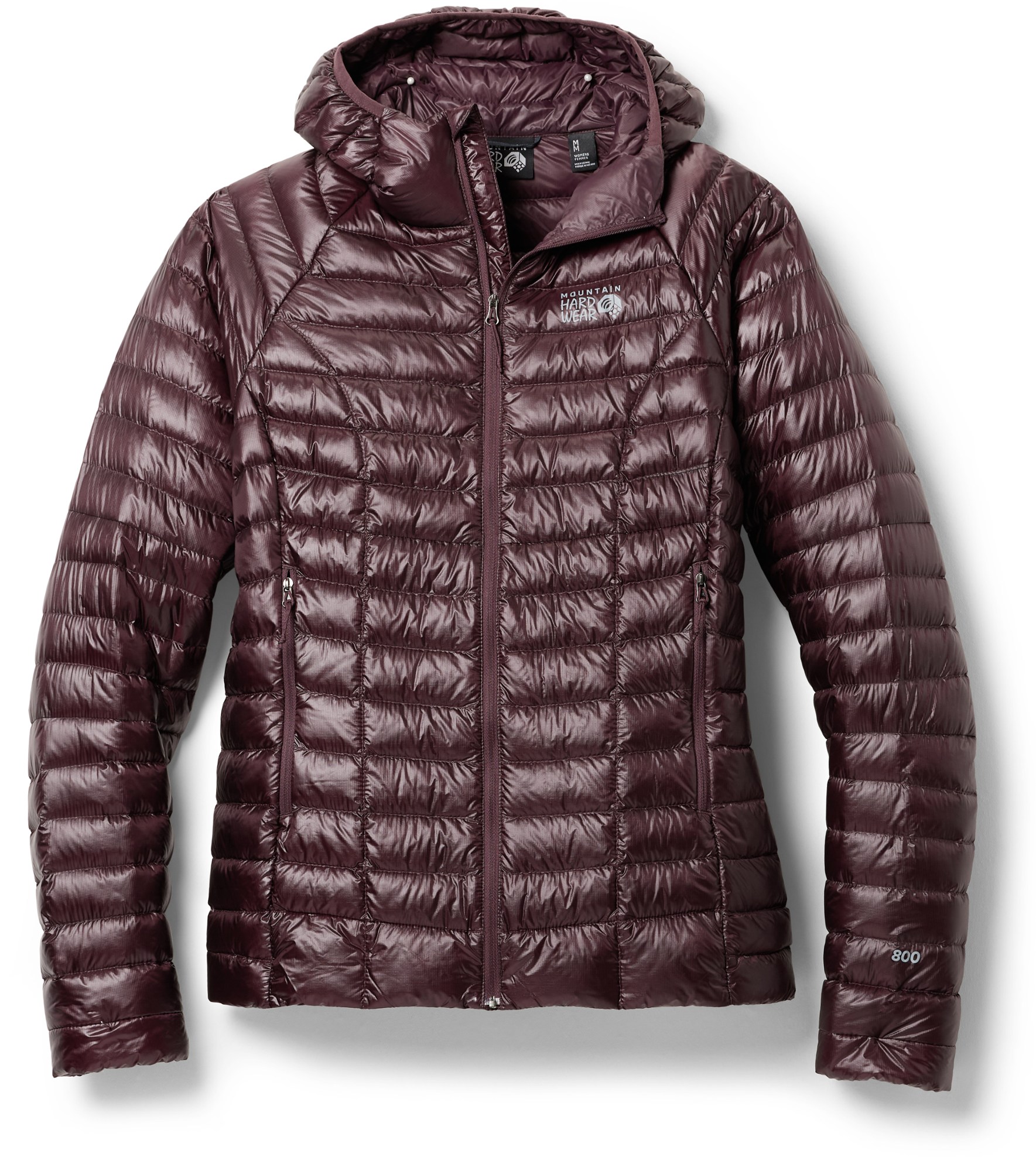 Category: Ultralight
Category: Ultralight
Weight: 8.5 oz.
Fill: 2.8 oz. of 800-fill down
What we like: One of the best warmth-to-weight ratios on this list.
What we don’t: Not as premium as the more affordable Rab Mythic Alpine Light above.
For backcountry missions when every ounce counts, you’ll need a jacket that offers big warmth for a low weight. Enter the 8.5-ounce Mountain Hardwear Ghost Whisperer, one of the most impressive jackets in its class. You get 2.8 ounces of premium 800-fill down in a package that stuffs down smaller than a 1-liter Nalgene (complete with a carabiner clip loop). Impressively, despite the low weight and small packed size, the Ghost Whisperer doesn’t compromise much on functionality or features with zippered hand pockets, hood and hem adjustments, and decent wind and water resistance. With the latest update, Mountain Hardwear even incorporated synthetic fill at the first baffle of each cuff, which is a small but thoughtful addition that helps prevent wetting out when playing in the snow or washing your hands.
However, while the Ghost Whisperer is built to resist a light chill at the belay ledge or during a summer evening at camp, it’s notably less insulated than most other options here (when you factor in the difference in fill power, it’s approximately as warm as the REI 650 above). And with a thin (10D x 10D) shell, we don’t recommend it as your daily driver. Finally, compared to the Rab Mythic Alpine Light above, the Ghost Whisperer is $30 pricier, 0.5 ounces heavier, and uses lower-fill-power down along with synthetic fill only at the cuffs (the Rab features synthetic at the sides, cuffs, shoulders, and base of the hood). For the most diehard ounce counters, Mountain Hardwear also makes the Ghost Whisperer UL Hoody, which features a 5-by-7-denier shell, 1,000-fill down, and clocks in at only 6.2 ounces.
Read more: MH Ghost Whisperer Hoody review (prior men's version)
See the Mountain Hardwear Ghost Whisperer Hoody
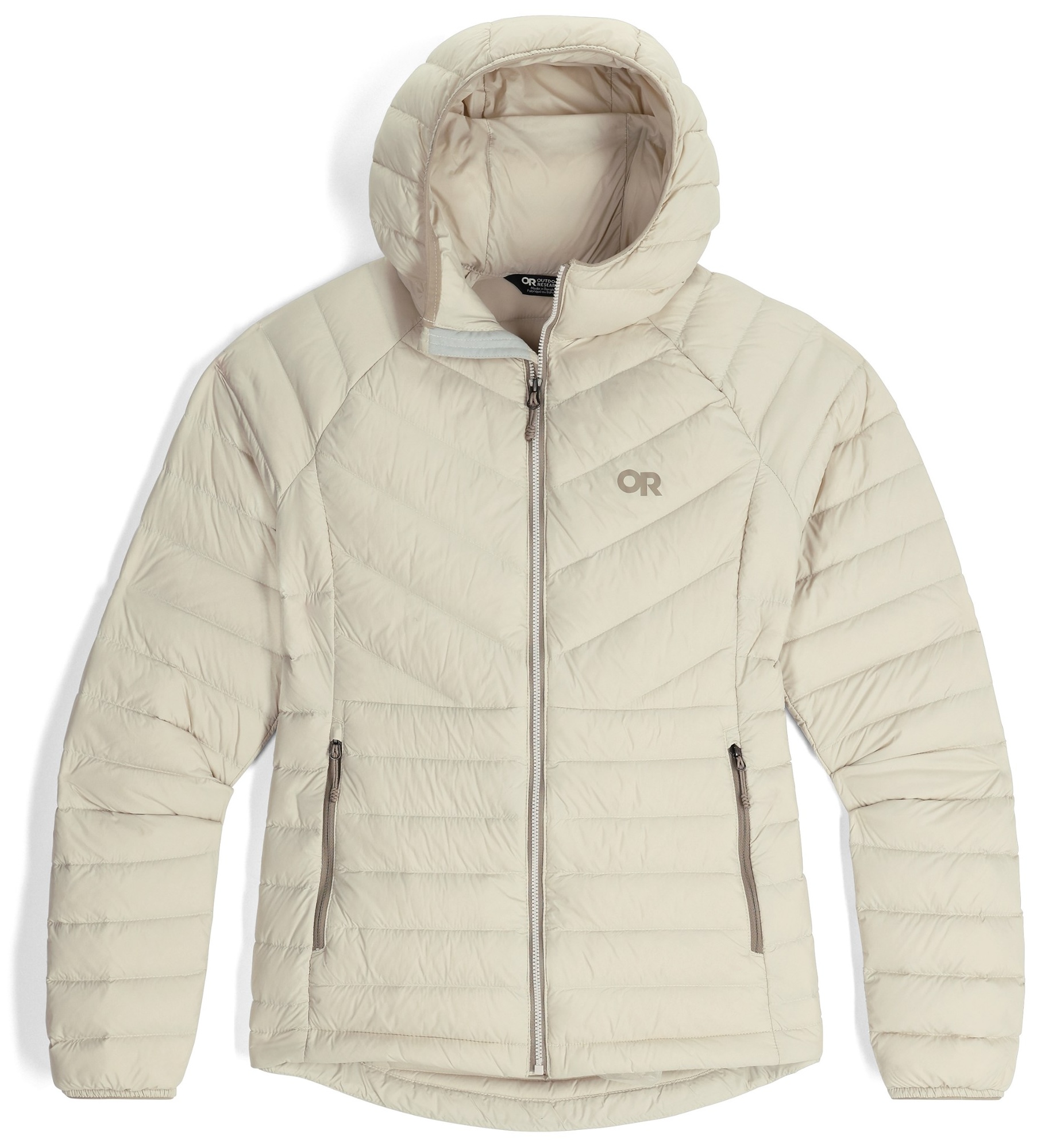 Category: Lightweight
Category: Lightweight
Weight: 11.6 oz.
Fill: 4.2 oz. of 800-fill down
What we like: Comfortable, lightweight, and a solid value for what you get.
What we don’t: Less refined than Patagonia’s Down Sweater Hoody.
Outdoor Research’s Transcendent was a mainstay in their lineup but went away a few years ago. Reintroduced in 2024, we think the latest version was worth the wait. The recipe—while not revolutionary—is proven and versatile, including high-quality 800-fill down packed inside a 20-denier shell. Additionally, warmth and weight are both very competitive, with the Transcendent Hoodie packing in 4.2 ounces of insulation in an 11.6-ounce package—for comparison, that’s 0.2 ounces more down for 0.5 ounces less than Patagonia’s Down Sweater Hoody. And impressively, OR managed to achieve this at a very palatable $279 price point (the non-hooded Transcendent is $259), which is $50 less than the Patagonia.
However, there’s more to the story than what meets the eye. First is fit, which we found to be a little boxier and less flattering than the well-tailored cut you get from Patagonia or Arc’teryx. Further, while the Transcendent and Down Sweater both feature 20-denier shells, the former hasn’t held up as well in testing—we came away with a small tear after just a couple days of backpacking, while the Down Sweater has lasted us multiple seasons (in more abrasion-prone environments) without issue. Finally, we think the Patagonia has a plusher and more sleeping bag-like feel than the Transcendent, but the OR isn’t far off with tricot-lined hand pockets and a very smooth interior that makes it easy to layer underneath. Taken together, we consider the Down Sweater to be the more refined piece overall (hence our ranking), but the Transcendent will save you some cash without making any major compromises. Bonus: It’s offered in plus sizes up to 4X, as well as a parka-length version that’s a similarly strong value at $299.
Read more: OR Transcendent Down Hoodie review
See the Outdoor Research Transcendent Hoodie
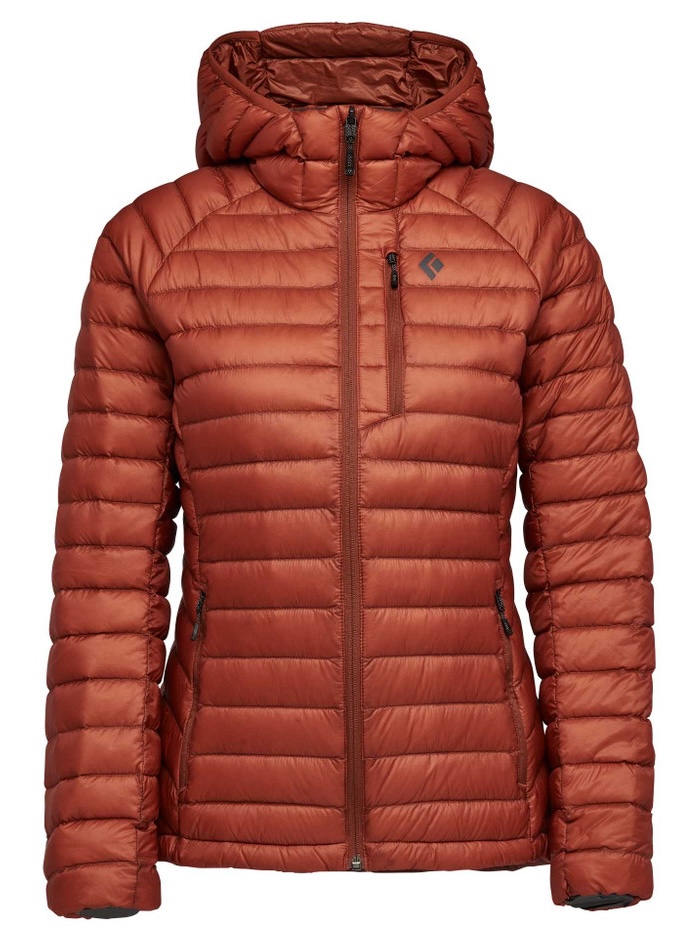 Category: Lightweight
Category: Lightweight
Weight: 10.1 oz.
Fill: 3.5 oz of 800-fill down
What we like: A simple and well-executed lightweight option with a nice array of technical features.
What we don’t: Thin shell fabric and not the best value.
We love a good Black Diamond product, and the Approach Down Hoody earns a place in our lineup after accompanying us on a backpacking trip in Chilean Patagonia. This jacket is simple and lightweight without being barebones—the feature set felt just right to us in the majority of situations we threw at it. The Approach stuffs compactly into its right hand pocket (which has a fabric loop for clipping to a carabiner), and the smaller details like zippers and pulls have a robust and premium feel. Additionally, the hand pockets are massive (big enough for a large map or even climbing skins), and the hood is climbing helmet-compatible. With a PFAS-free DWR coating and 800-fill-power, RDS-certified down that's treated for water resistance, the Approach is a solid and intentionally built addition to any layering system.
After five days of hard use, our Approach Hoody did have some random feathers coming out, both at seams and from a small abrasion in the fabric. With only a 10- by 7-denier lightweight nylon shell, this isn't a hoody you can absentmindedly abuse. And while it's $20 cheaper than the Arc'teryx Cerium above, the materials and down just aren't as premium. Our lineup also offers several other options that are cheaper, lighter, and use higher-quality down—like the Rab Mythic Alpine and Himali Accelerator above. Still, the Approach offers a slim and mobile design with thoughtful, climbing-focused features from a reputable mountain brand.
See the Black Diamond Approach Hoody
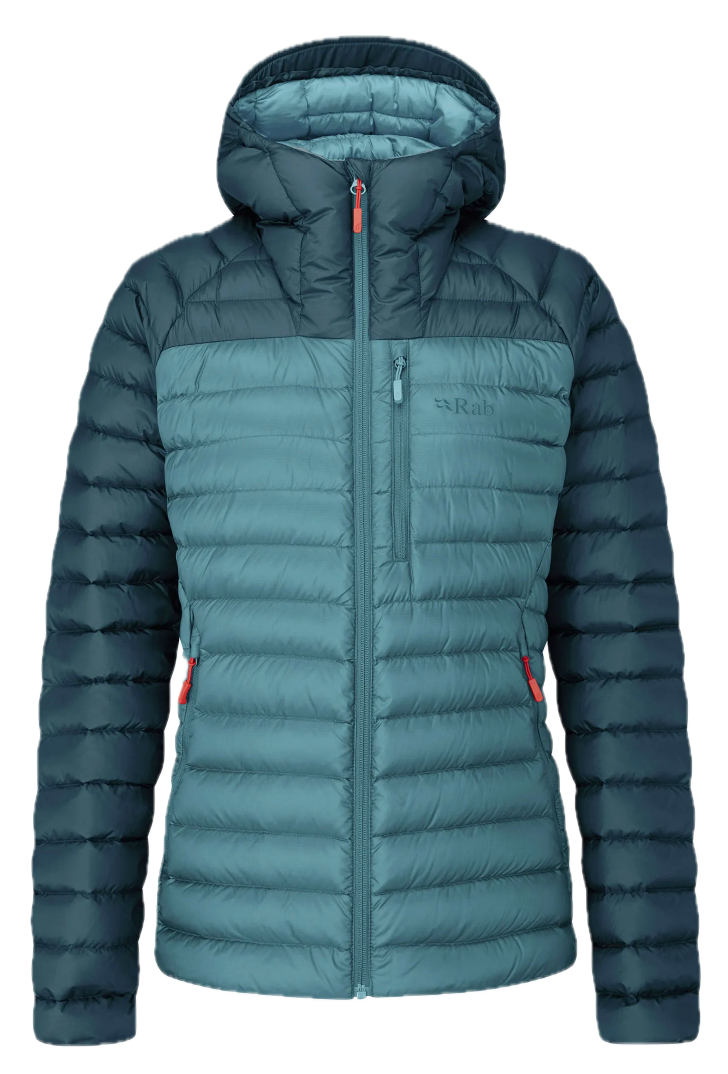 Category: Midweight
Category: Midweight
Weight: 14.6 oz.
Fill: 5.1 oz. of 700-fill down
What we like: Warm for the price; water-resistant build.
What we don’t: Not as warm or packable as the OR Transcendent.
Like the heavyweight Neutrino Pro and ultralight Mythic Alpine Light above, Rab’s popular Microlight Alpine Jacket pays tribute to the brand’s climbing heritage. To start, it's built to handle wind and light moisture thanks to a tough Pertex Quantum shell, DWR coating, and hydrophobic down. Further, the rigid structure of the jacket’s brimmed hood has a hardshell-like feel, offering great all-around coverage and protection. You’ll still want to don a waterproof layer if the skies open up, but the Microlight Alpine stands out as one of the more weather-ready midweight down jackets we’ve tested.
With medium-quality 700-fill-power down, the Rab falls a bit short for weight- and space-conscious adventures like alpine climbing. By contrast, the Transcendent above is 3 ounces lighter, but its 800-fill down offers a bit more warmth and a more packable design. Both have 30D fabric, but the Transcendent also shaves $16 off the price. That said, we do think the Microlight Alpine is a highly versatile option for everyday use, and we tend to find Rab's pieces more attractive overall. At the end of the day, either option is a solid pick.
Read more: Rab Microlight Alpine review
See the Rab Microlight Alpine
 Category: Heavyweight
Category: Heavyweight
Weight: 2 lb. 3.5 oz.
Fill: 8.3 oz. of 700-fill-power down
What we like: A true knee-length parka with a durable woven shell.
What we don’t: Expensive and sizing can be tricky.
Outdoor Research is often a great option for technical pieces at more approachable price points, but with the Coze Down Parka, they've gone fully urban and casual—and we're here for it. High-quality materials meet a cozy and long jacket that we love snuggling into. In fact, the aptly named Coze is the largest parka on our list, with a 43-inch center back length (9 in. longer than the Marmot Montreal above) that easily reaches the knees. The shell is soft yet durable with a 70- by 90-denier weave and has side zippers to allow easier movement when walking, sitting, or driving.
Not everyone needs this much coverage, but if you live in an especially frigid area and want something practical for everyday use, the Coze is a great option. The long length will help your legs stay warm without insulated bottoms, and your booty won't get cold if you're waiting on a chilly bus stop bench. The fluff of this parka isn't as elegant as more tailored winter options like the Patagonia Tres 3-in-1 or even their cheaper Down With It Parka above, but it's still a good-looking piece. Choosing the right size for the Coze can be tricky, so if you can try it on before you buy (or purchase from a retailer with a good return policy), we recommend doing so. But overall, for great coverage from a trusted brand, the Coze is has a lot of appeal.
See the Outdoor Research Coze Down Parka
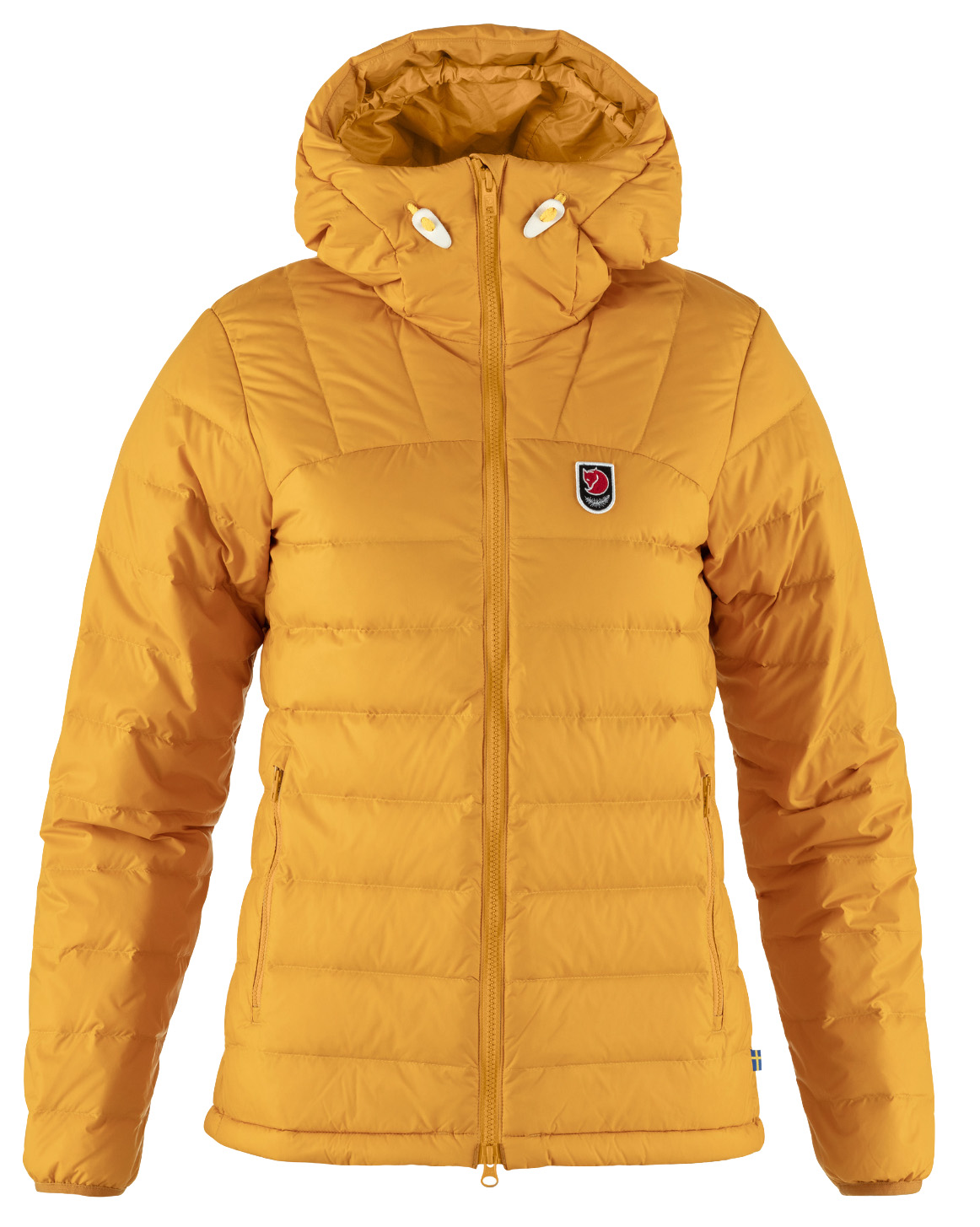 Category: Lightweight
Category: Lightweight
Weight: 15.3 oz.
Fill: 3.5 oz. of 700-fill down
What we like: A technical down jacket with classy Scandinavian styling.
What we don’t: Not as warm or light as other options here.
Style and technical performance don’t always go hand in hand, but Fjallraven manages to merge the two better than most. On paper, their Expedition Pack Down Hoody looks a lot like many other jackets here: You get 3.5 ounces of 700-fill down and horizontal baffling in a sub-1-pound build that packs nicely into its own pocket. But the devil is in the details here: The Expedition boasts a layer of synthetic insulation over the shoulders for added protection against moisture, and contrasting pullcords and leather tabs at the collar and a classy logo patch on the chest add a nice dose of flair. For days that start at the trailhead and end at the brewery, the Fjallraven is a versatile and standout piece.
We’re used to paying a pretty penny for all things Fjallraven, so it surprised us to see the Expedition priced relatively affordably at $280 (for comparison's sake, Patagonia's Down Sweater Hoody above is $329). But with a larger dose of higher quality down, the Patagonia is significantly warmer, and it's over 3 ounces lighter, too (12.1 oz.). Alternatively, Cotopaxi’s Fuego below is another option that nicely balances around-town-friendly looks and performance with a distinctive casual appearance and higher-quality down. But these are minor nitpicks if you like Fjallraven’s styling (we do), and it’s hard to argue with the Expedition’s premium all-around design.
Read more: Fjallraven Expedition Pack Down Hoodie review (men's version)
See the Fjallraven Expedition Pack Down Hoodie
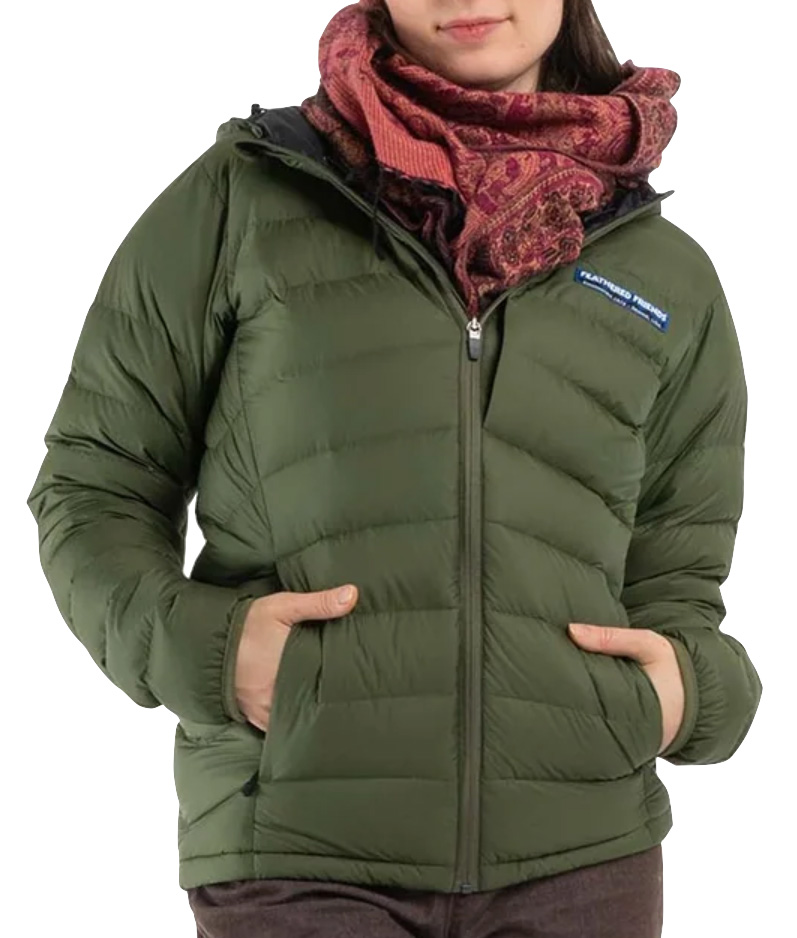 Category: Lightweight
Category: Lightweight
Weight: 11.1 oz.
Fill: 3.7 oz. of 900-fill down
What we like: Premium build quality and superb warmth-to-weight ratio.
What we don’t: Not a standout value; weight went up by over an ounce with the latest update.
Most of the brands here design and produce full lineups of outerwear, ranging from hardshells to hiking pants and more. But not Feathered Friends. As their name implies, just about every product made by this Seattle-based company is stuffed with high-quality down, from sleeping bags and insulated pants to jackets and bedding. As true down specialists, Feathered Friends’ jackets stand out from the rest for their quality craftsmanship, ethically sourced materials, and high performance for serious outdoor-goers.
With that in mind, it comes as little surprise that the Feathered Friends Eos is one of the most technically savvy jackets here. The Eos packs 3.7 ounces of 900-fill goose down into an 11.1-ounce package—a very impressive amount of warmth for the weight. You do pay a bit of a premium at $409, and the technical appearance of this jacket certainly doesn’t have as much daily appeal as the Down Sweater or Cerium above. What’s more, the hood drawcords lack the fit and finish of most modern designs—you’ll need two hands to adjust the hood at each side of the collar, and the elastic sticks out at the neck when cinched. But for lightweight warmth in a premium package, the Eos is a great match for serious adventurers..
Read more: Feathered Friends Eos review (prior version)
See the Feathered Friends Eos
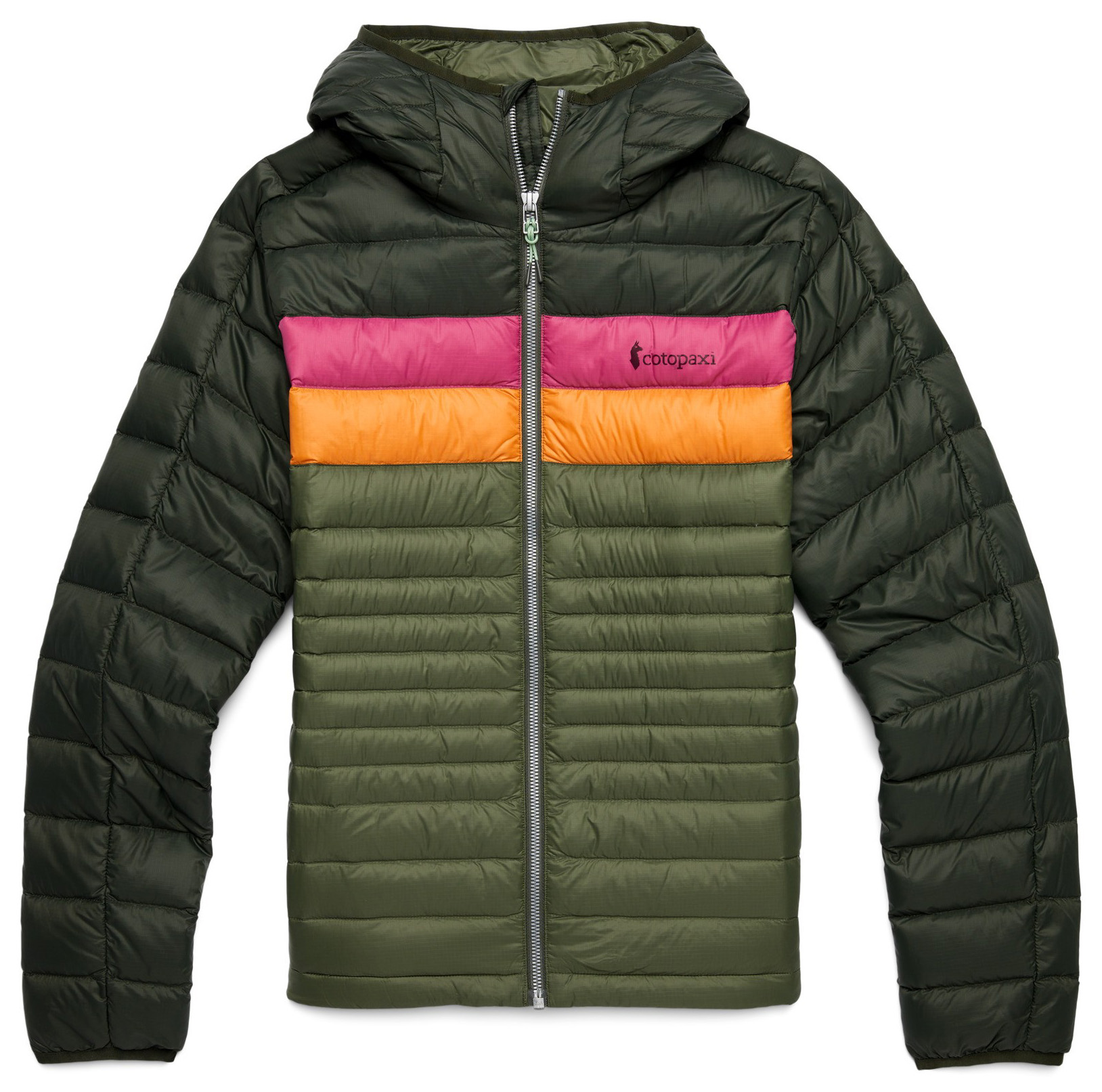 Category: Lightweight
Category: Lightweight
Weight: 14.0 oz.
Fill: 800-fill-power down
What we like: Retro styling with premium down fill.
What we don’t: No fill weight provided, and not the softest hand feel.
There’s no shortage of down jackets to choose from, but the Cotopaxi Fuego stands out with its fun, retro styling. Featuring premium 800-fill down and a versatile 20-denier shell that is reasonably tough yet lightweight, the Fuego is well built and capable despite its clear casual intentions. Of course, the retro styling is its calling card, and the Fuego is offered in a lot of fun colorways, as well as some more toned-down solid designs if that's more your jam. Throw in responsibly sourced down and the fact that Cotopaxi is a certified B Corp, and the Fuego is an easy jacket to get behind.
In terms of competitors, Patagonia’s Down Sweater Hoody ($329) uses the same 800-fill-power down and 20-denier shell but is a full 4 ounces lighter. Without the Cotopaxi’s fill weight, it’s difficult to precisely nail down which is the better insulated jacket, but the Patagonia is the clear winner when it comes to warmth-to-weight. On the other hand, the Fuego will save you some bucks, and Cotopaxi’s trademark colorblocking has become a common sight on both mountain slopes and city streets. The most discernible difference is material quality: The men’s Fuego that we tested had a noticeably plasticky and slippery feel compared to the smooth and cozy Patagonia. But for those who don’t mind a little extra weight and bulk, the Cotopaxi Fuego hits a nice balance of casual appeal and value, which is why it’s included here.
Read more: Cotopaxi Fuego Hooded review (men's version)
See the Cotopaxi Fuego Hooded
| Jacket | Price | Weight | Category | Down Fill | Denier | Packable |
|---|---|---|---|---|---|---|
| Patagonia Down Sweater | $329 | 12.1 oz. | Lightweight | 4.0 oz. of 800 fill | 20D | Chest pocket |
| Arc’teryx Cerium Hoody | $400 | 10.2 oz. | Lightweight | 3.2 oz. of 850 fill | 15D | Stuff sack |
| REI Co-op 650 Down Jacket | $129 | 10.2 oz. | Lightweight | 3.3 oz. of 650 fill | 20D | No |
| Rab Mythic Alpine Light | $330 | 8.0 oz. | Ultralight | 2.1 oz. of 900 fill | 10D | Stuff sack |
| Patagonia Down With It Parka | $349 | 2 lb. 5.0 oz. | Midweight | 8.3 oz. of 600 fill | 50D | No |
| Rab Neutrino Pro | $400 | 1 lb. 1.7 oz. | Heavyweight | 7.5 oz. of 800 fill | 20D | Stuff sack |
| Mountain Hardwear Stretchdown | $300 | 15.5 oz. | Lightweight | 3.3 oz. of 700 fill | Unavail. | No |
| Himal Accelerator | $330 | 11.0 oz. | Lightweight | 4.0 oz. of 850 fill | Unavail. | Stuff sack |
| Marmot Montreal Coat | $300 | 2 lb. 0 oz. | Midweight | 700 fill | Unavail. | No |
| Outdoor Research Coldfront | $279 | 1 lb. 5.2 oz. | Midweight | 5.6 oz. of 700 fill | 30D | Hand pocket |
| MH Ghost Whisperer Hoody | $360 | 8.5 oz. | Ultralight | 2.8 oz. of 800 fill | 10x10D | Hand pocket |
| Outdoor Research Transcendent | $279 | 11.6 oz. | Lightweight | 4.2 oz. of 800 fill | 20D | Hand pocket |
| Black Diamond Approach | $380 | 10.1 oz. | Lightweight | 3.5 oz. of 800 fill | 10Dx7D | Hand pocket |
| Rab Microlight Alpine | $295 | 14.6 oz. | Midweight | 5.1 oz. of 700 fill | 30D | Stuff sack |
| OR Coze Down Parka | $399 | 2 lb. 3.5 oz. | Heavyweight | 8.3 oz. of 700 fill | 70Dx90D | No |
| Fjallraven Expedition Pack Down | $280 | 15.3 oz. | Lightweight | 3.5 oz. of 700 fill | Unavail. | Hand pocket |
| Feathered Friends Eos | $409 | 11.1 oz. | Lightweight | 3.7 oz. of 900 fill | 12Dx20D | Stuff sack |
| Cotopaxi Fuego Hooded | $295 | 14.0 oz. | Lightweight | 800 fill | Unavail. | Inner pocket |
The Switchback Travel team has been testing down jackets all over the world for almost a decade. We started with our unisex round-up before Jenny Abegg created this women's-specific guide in 2020 based on feedback from our female editorial staff and testers. The market is always shifting and changing—especially for women's wear—and so has this guide, though some options have withstood the test of time, including the longstanding Patagonia Down Sweater and Arc'teryx Cerium Hoody. Editor-in-chief Penney Garrett heads up this review now, putting these down jackets to the test in Lake Tahoe, California, a location with no shortage of wind, snow, and cold. Whether she's out on a daily dog walk or strapping on her ski boots, Penney loves picking out the perfect jacket for the job. Managing editor Sarah Nelson also has a hand in keeping things current, contributing her expertise as an avid climber, backpacker, and skier who spends most of the year traveling to explore crags, trail networks, and ski resorts throughout the country.
To determine which models end up in this competitive round-up, we start by deep-diving into market research and consumer trends. We are also always talking to friends and athletes in our community to learn what they love, what they are excited about, and why. We assess every spec, from fill power to waterproofing treatments to denier, and then hit the trail, crag, or slopes with multiple options on hand. From weight to packability to features, rest assured the jackets on our list are there for a reason. As always, we will update our picks as new products get released or updated.
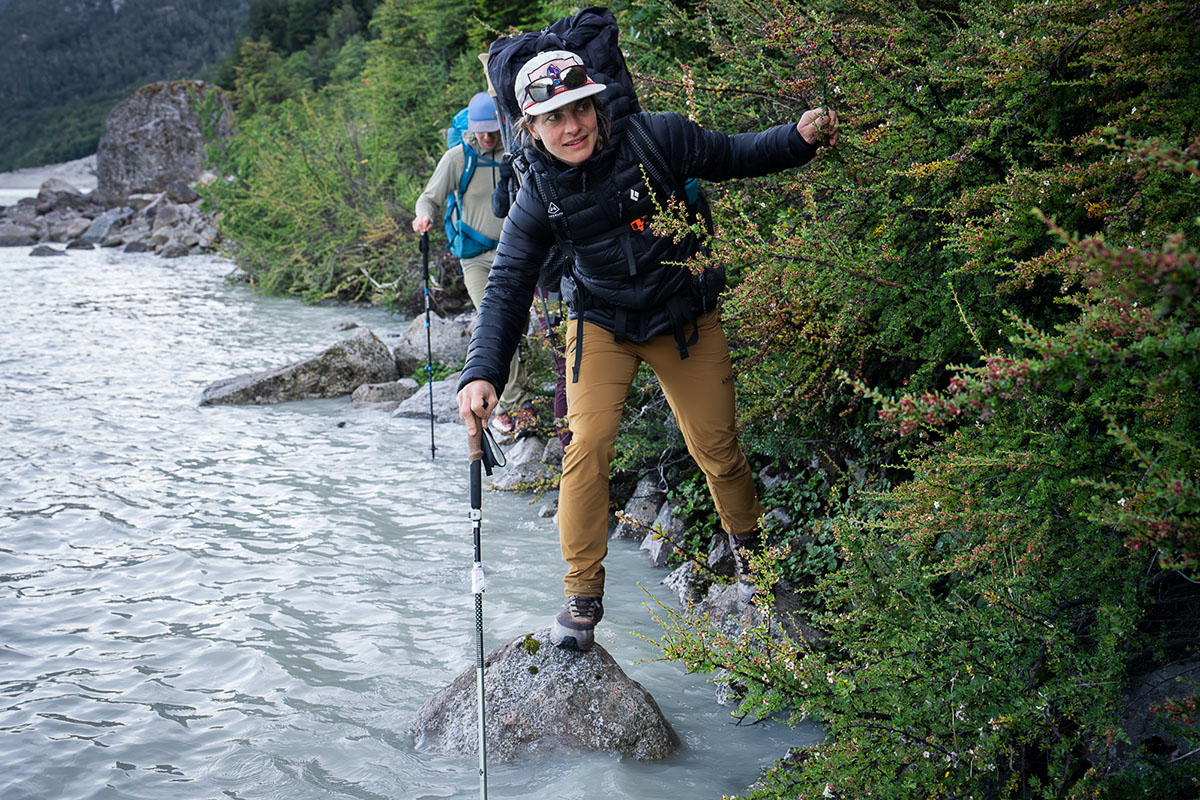
The first step in finding the best women's down jacket is determining what your end use will be. Although many down jackets are ideal for mountain environments and outdoor activities given their lightweight and packable nature, down jackets are also our first choice for everyday warmth in the cold winter months. In our picks above, we often call out a jacket’s intentions. If you’re in the market for a technical piece for skiing, hiking, climbing, and other human-powered activities, look for high fill power, low weight, and features like a helmet-compatible hood and two-way zipper. These jackets will likely have thinner fabrics (read: less durability), trimmed-down feature sets, and slim fits (the Arc’teryx Cerium Hoody and Rab Mythic Alpine Light are prime examples). For everyday use, jackets will have thicker shell fabrics, regular fits that are great for layering, and even features like knee-length hems and fur-brimmed hoods for the parkas. Casual jackets will also generally use lower-quality down and weigh more.
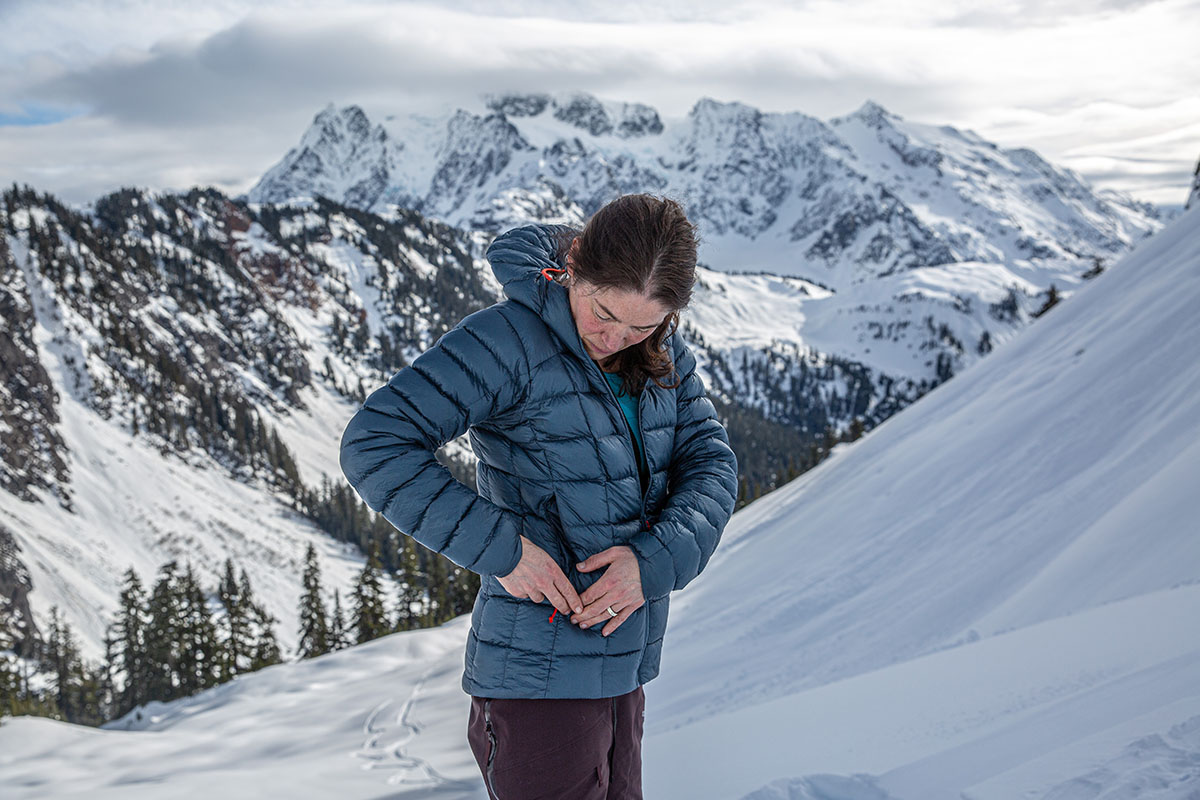
Some jackets do a great job at splitting the casual/technical difference, with competitive warmth-to-weight ratios but fits and finishes that transition nicely for around-town use. The entire down sweater category fits this bill, a designation that describes a traditional-looking puffy jacket with fewer performance-focused features than the technical pieces mentioned above. For example, the Patagonia Down Sweater Hoody, Outdoor Research Transcendent, and Cotopaxi Fuego are all great for casual wear but also lightweight enough to pack for active pursuits. If you’re in the market for a single down jacket that works well in almost every environment, down sweaters are a great place to start.

Lightweight
This is the industry's most popular down jacket category thanks to its versatility. We love lightweight options for everything from daily wear to easier adventures to winter sports. This category encompasses most down sweaters, and these lightweight pieces are great either on their own or as a midlayer in a more comprehensive layering setup. Another bonus is that lightweight options usually have more features and better durability than ultralight models while remaining less bulky and cumbersome than mid- or heavyweight contenders. The ideal temperature for lightweight jackets will depend on how you are layering and what you're doing, but we feel they are best in the 35- to 50-degree Fahrenheit range (we discuss this more in “Our Estimated Temperature Scale” below). Some of our favorite examples in this category are the Patagonia Down Sweater, REI Co-op 650 Down Jacket, Mountain Hardwear Stretchdown, and Outdoor Research Transcendent.

Ultralight
If you're looking for something targeted and purpose-built for backpacking, backcountry skiing, climbing, or other weight-conscious activities, then an ultralight down jacket is not to be missed. These jackets often have similar fill weights to lightweight options but are able to shave ounces thanks to the use of more premium down, minimal features, and thinner shell fabrics. While we often see jackets in this category like the Mountain Hardwear Ghost Whisperer Hoody or Rab Mythic Alpine Light worn around town, this isn't something we'd recommend due to their minimalist and more fragile designs. We like to reserve the use of these high performers for fast-and-light pursuits, where every ounce counts.
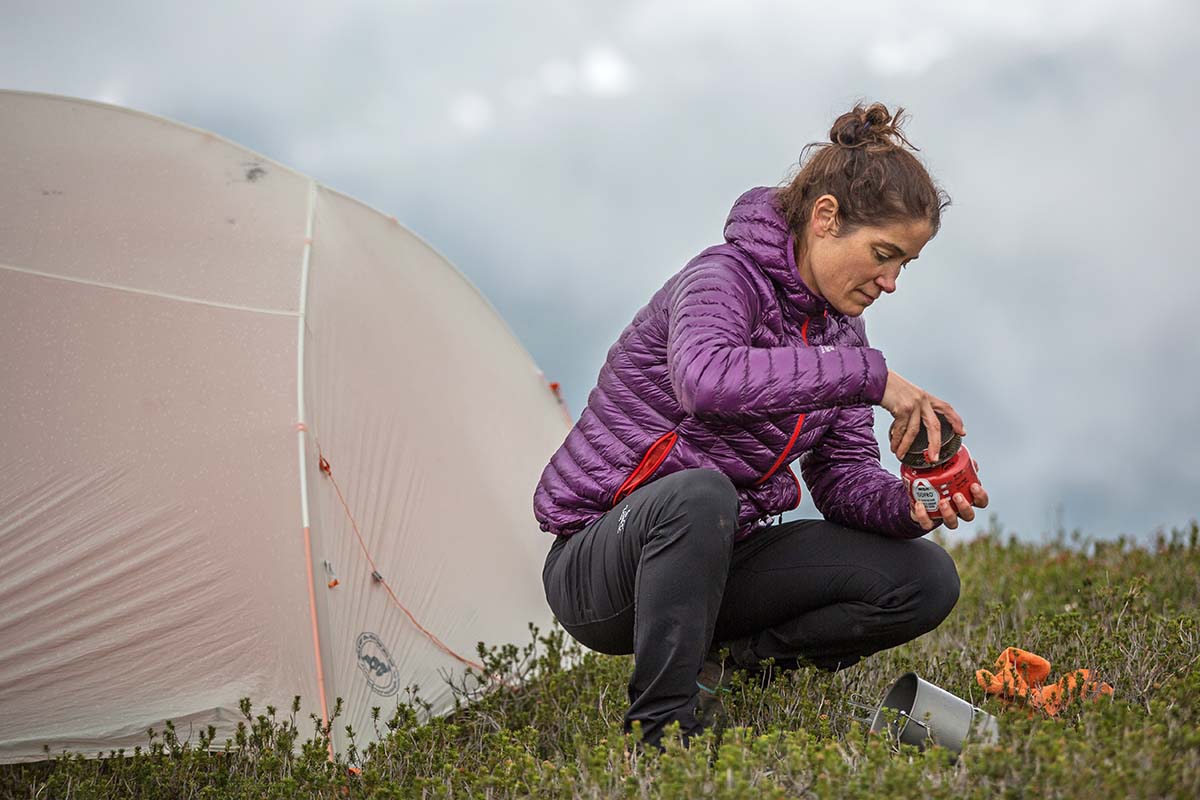
Midweight and Heavyweight
If you know you need something significantly warmer than the above categories, consider a mid- or heavyweight jacket. Designed for more serious winter conditions, jackets in this sector will have fill weights of 6 to 7 ounces or more (like the Rab Neutrino Pro with 7 oz. of down). These options are also much puffier, so take note that they won't pack down as compactly if space is a concern. Our lineup here has several options that fit in this designation, but for more winter-specific options, check out our article on the best women's winter jackets.
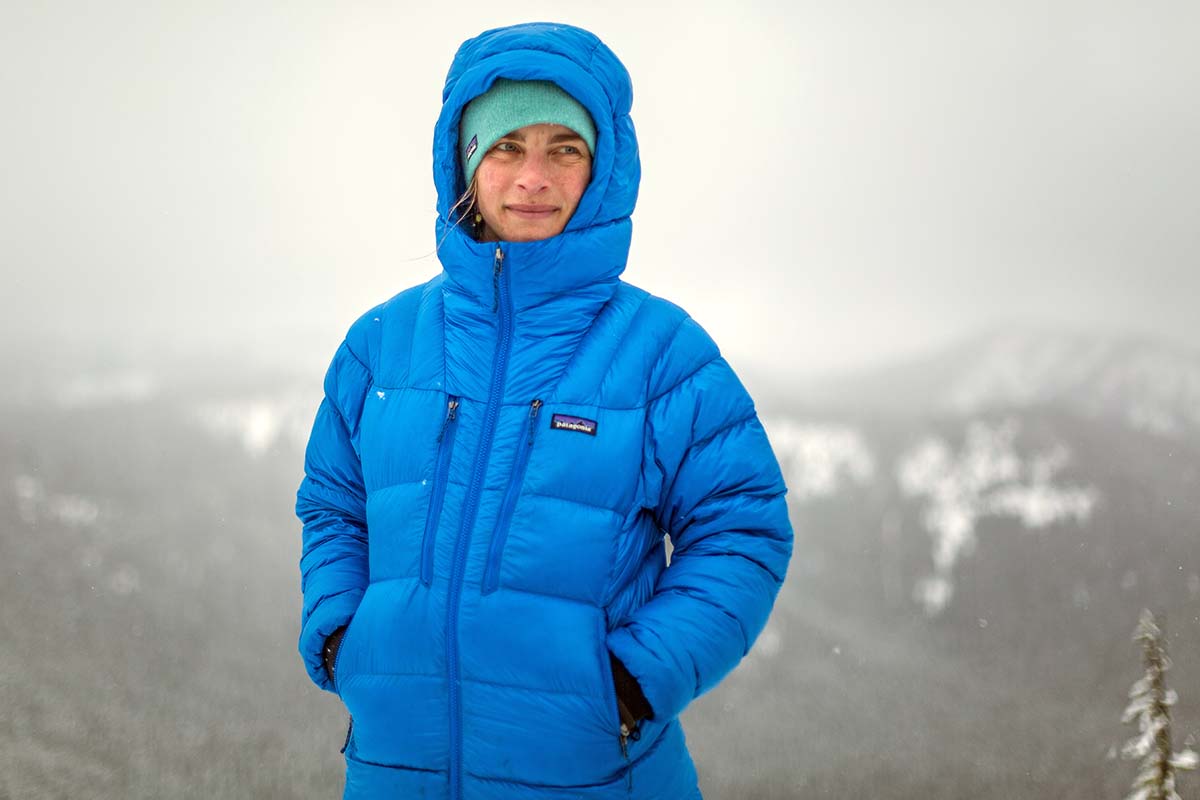
Simply put, nothing beats the lofty and premium warmth that down provides. Down insulation functions so effectively because the loose clusters of feathers are great at trapping body heat. We’d love to have a temperature rating system to measure this warmth, but unlike sleeping bags (which are given an official EN rating), down jackets are more like the Wild West. Below is information that should help you fill in the gaps.
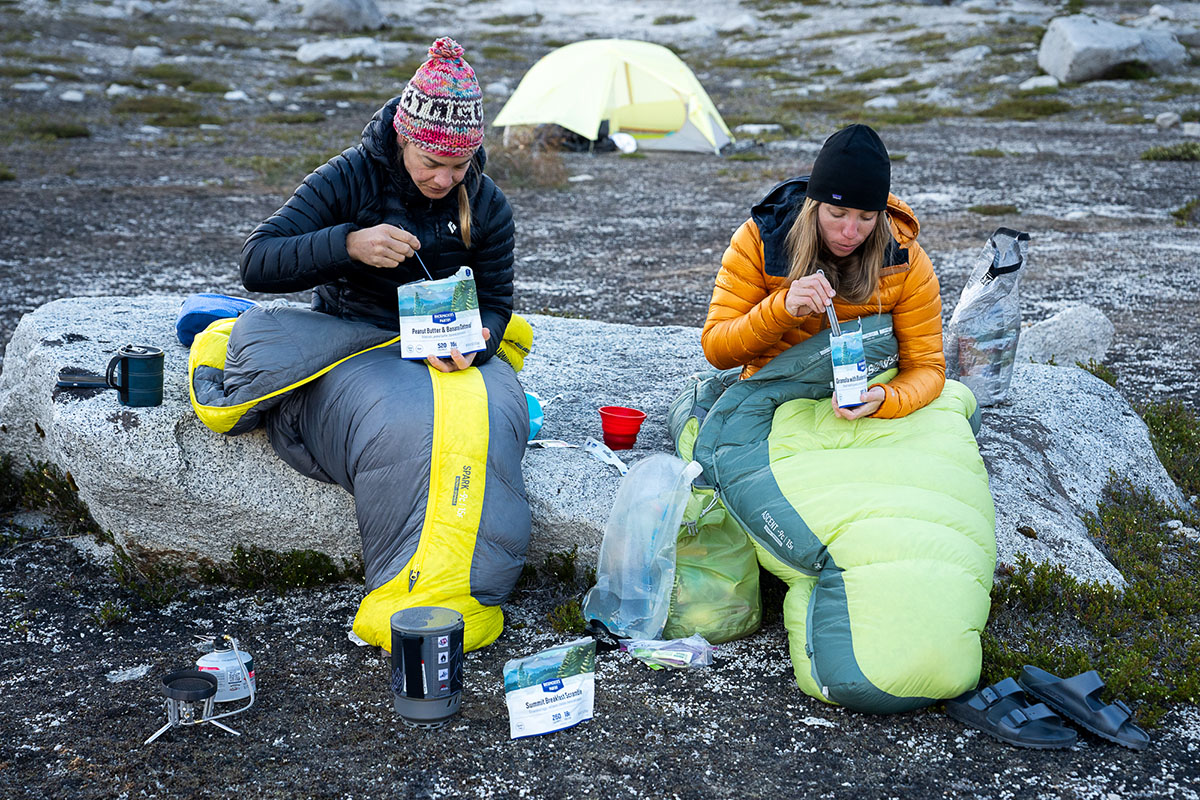
Fill Power
The quality of down is measured by fill power (700-fill, 800-fill, etc.); the higher the fill power, the better the down. This number (also known as loft) denotes how much space one ounce of down feathers takes up in a cylindrical tube. The more fill power or loft in a garment, the more body heat it can trap and, subsequently, the warmer you will be. To get the same level of warmth from lower-fill-power down requires using more of it, which adds bulk and weight to the final product.
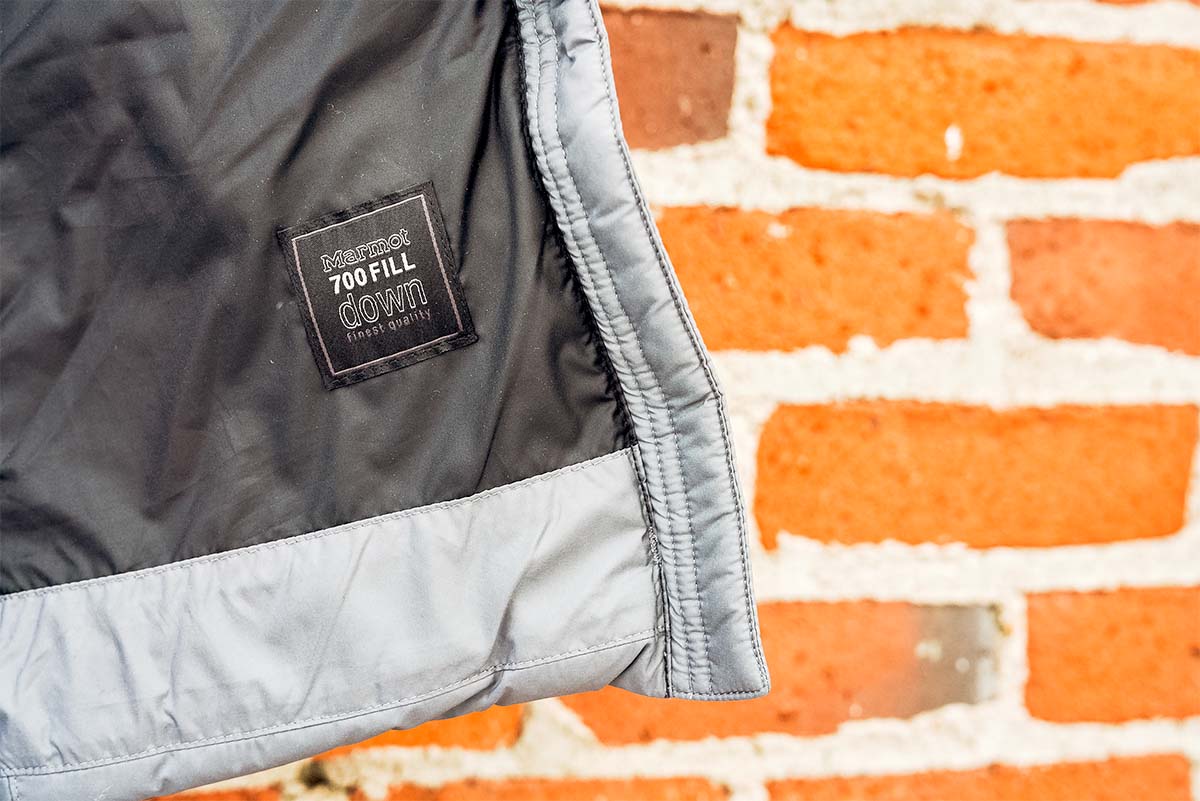
550- to 650-fill down is what you can expect in most entry- and mid-level down jackets and is just fine for daily use—though it's not the level you want for higher performance. Premium down will be 800-fill or above, and it's what you'll find in the most technical jackets from Patagonia, Arc'teryx, and Mountain Hardwear. If you go for this level, you can expect the best that down has to offer: A high level of warmth in a lightweight and ultra-compressible package. Some cottage brands like Feathered Friends even use 900-fill down or higher, though this is pretty rare.
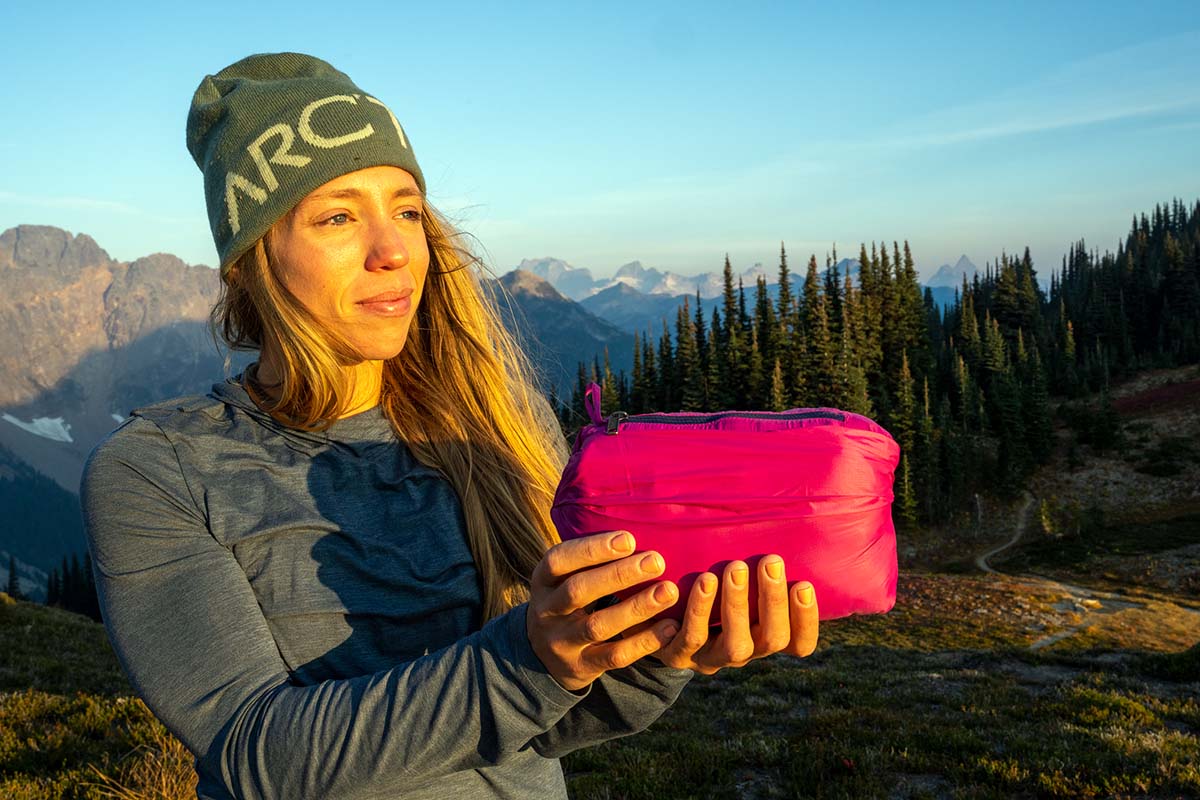
Fill Weight
You hear a lot about fill power, but fill weight is just as important—if not more so—when it comes to the actual warmth of a jacket. Fill weight is how much down is stuffed into your garment, measured in ounces. If you have one jacket with 3 ounces of 800-fill down and another with 6 ounces, the jacket with more physical down (6 oz.) will be warmer. By how much? We would guess the jacket with 3 ounces more down will be about 10 to 20 degrees Fahrenheit warmer. Down with a lower fill power will be less warm per ounce, so to retain a similar level of warmth, you would need a higher fill weight. We've noticed that fill weight gets a lot less press than fill power, adding to confusion for shoppers who only know to look at the fill power. It's not uncommon for manufacturers to not provide fill weight, and we've definitely had to call and email to track down this information (check out our article on Down Fill and Insulation Explained for more info on this topic).
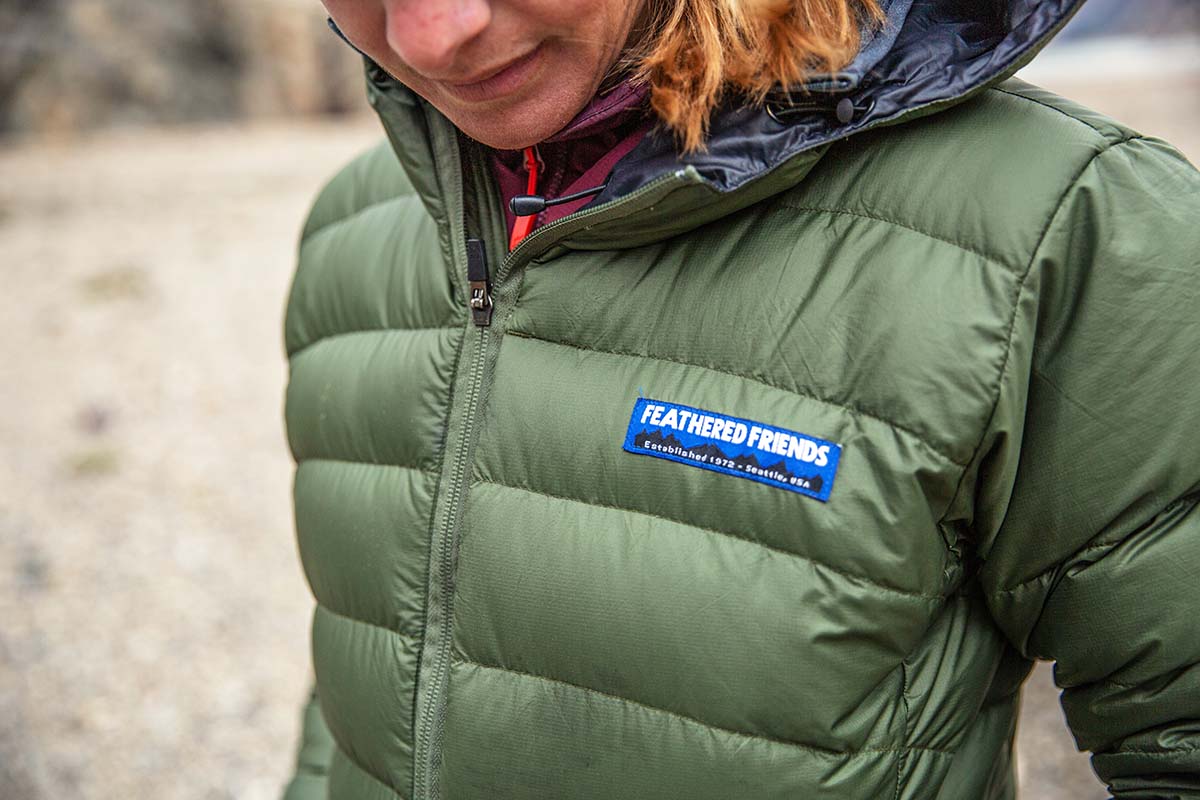
Our Estimated Temperature Scale
As mentioned above, there is an official EN rating (superseded by the new ISO standard) for sleeping bags, but nothing comparable for jackets—hence the difficulty in pinpointing exact temperature ranges for comfort at varying temperatures. A lot of things play into this, including fit, what other layers you are wearing, level of exertion and circulation, personal metabolism, and wind/weather. That said, we've found that ultralight and lightweight jackets, which generally have about 2 to 4 ounces of down, can provide adequate warmth for conditions in the 35- to 60-degree Fahrenheit range. A baselayer can add on another 5 to 15 degrees depending on its quality and thickness. For this reason, UL and lightweight jackets are ideal for 3-season high-altitude use and all but the coldest days in most U.S. cities.
When it gets truly cold (below freezing), it's time to step up to a mid- or heavyweight down jacket. Look for a fill weight of at least 4 ounces, though 5 to 6 ounces and above is probably ideal. The heavyweight Rab Neutrino Pro and Outdoor Research Coze Down Parka have 7 and 8.3 ounces of down respectively and are great for truly frigid temps. If you'll be at high altitude or in the bitter cold, look for something even heavier, like the Arc’teryx Cerium SV Hoody (the "severe weather" version of of the regular Cerium Hoody we feature above).
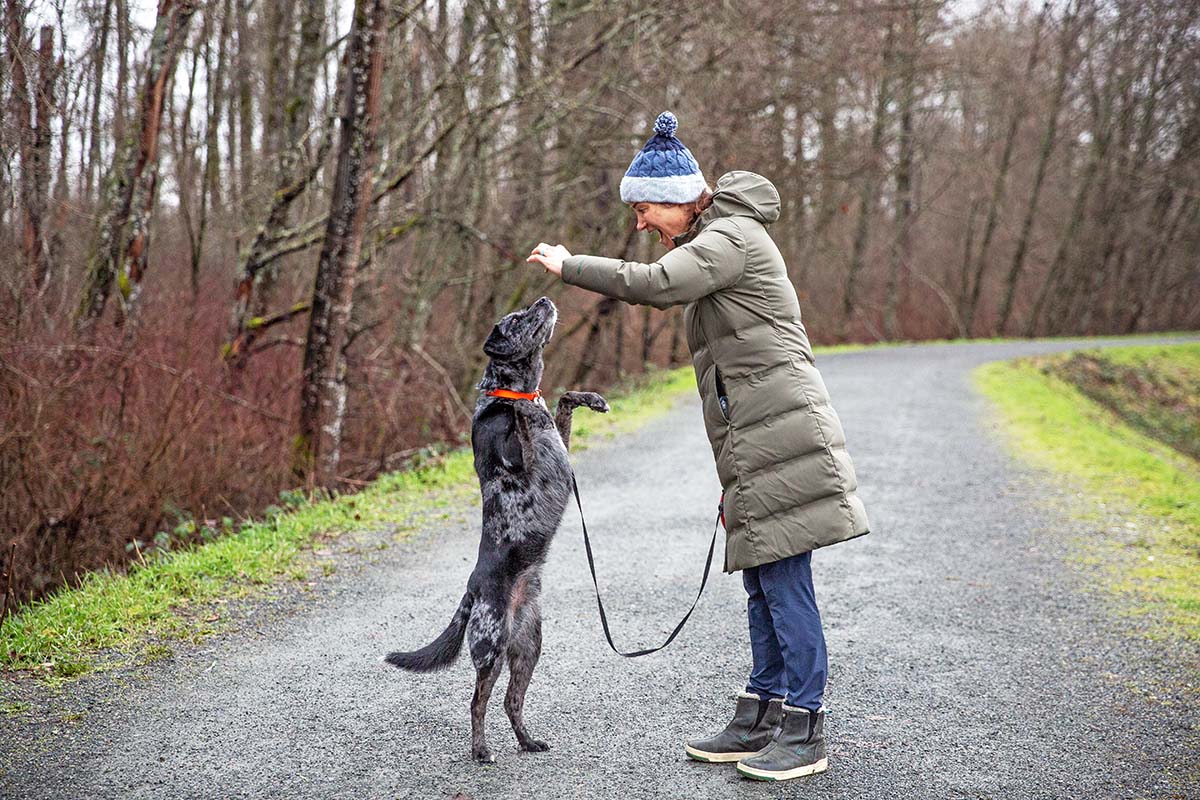
For uses like backpacking, climbing, mountaineering, ski touring—or whenever you have to lug around your own gear—the total weight of your down jacket should play a significant role in your buying decision. Jackets like the Rab Mythic Alpine Light (8 oz.) and Mountain Hardwear Ghost Whisperer (8.5 oz.) weigh very little for their warmth, and they will compress down extremely small in your pack. However, they also cost considerably more than your typical and more casual down sweater. On the other hand, if you need a layer for around-town and occasional outdoor uses like downhill skiing, you'll be completely fine with a somewhat heavier and more affordable build like the 1-pound-5.2-ounce Outdoor Research Coldfront.
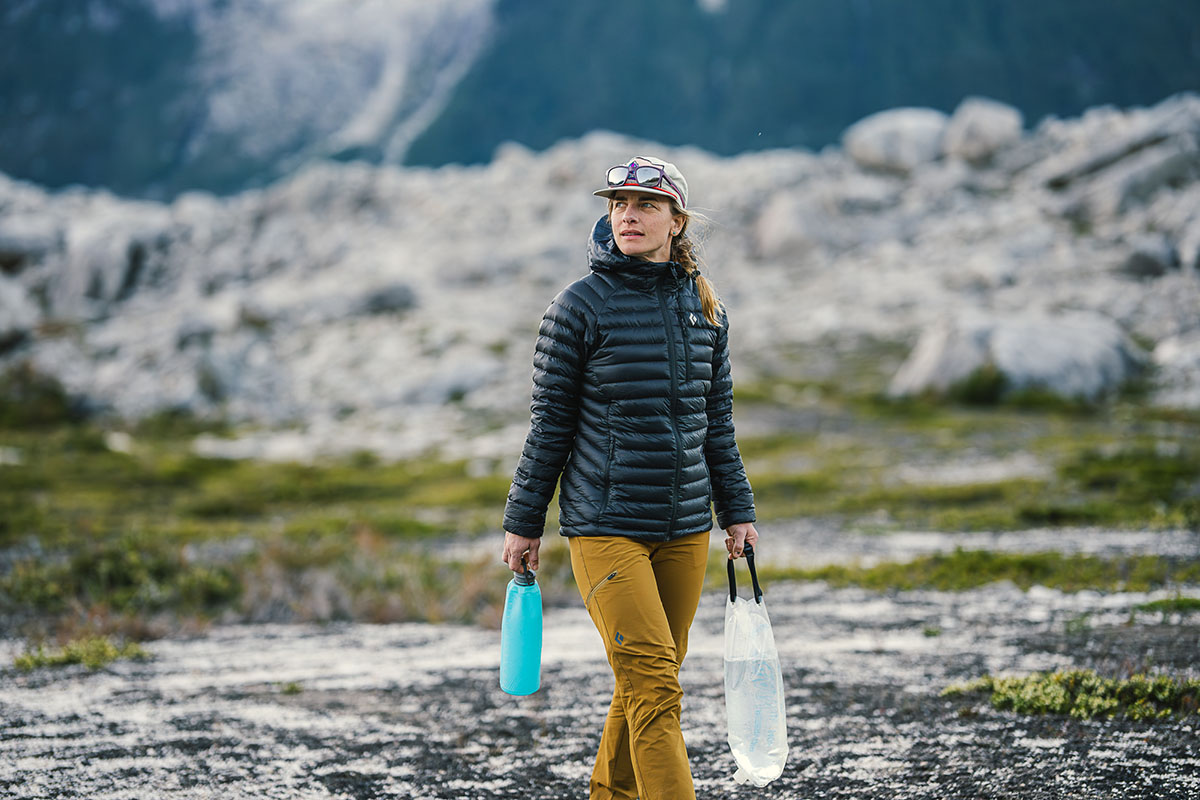
“Ultralight” is a buzzword of sorts that you will inevitably run into when shopping for a down jacket, and it’s worth noting there aren’t hard-and-fast rules as to what qualifies. We keep a close eye on the ratio of fill weight to total weight to see what lengths the manufacturer went to trim weight (the shell denier is a good hint too, and more on that below). At the extreme end of the spectrum is Mountain Hardwear’s Ghost Whisperer UL (see our in-depth review here), which packs 1.9 ounces of down inside a superlight 6.2-ounce package. When gear companies really prioritize cutting weight, you’ll see changes to zippers, a trim fit, and a lack of pockets. Some even opt for a pullover style to cut out half of the zipper. No matter what the manufacturer names a jacket, keep a close eye on fill weight and total weight to make your own determination.
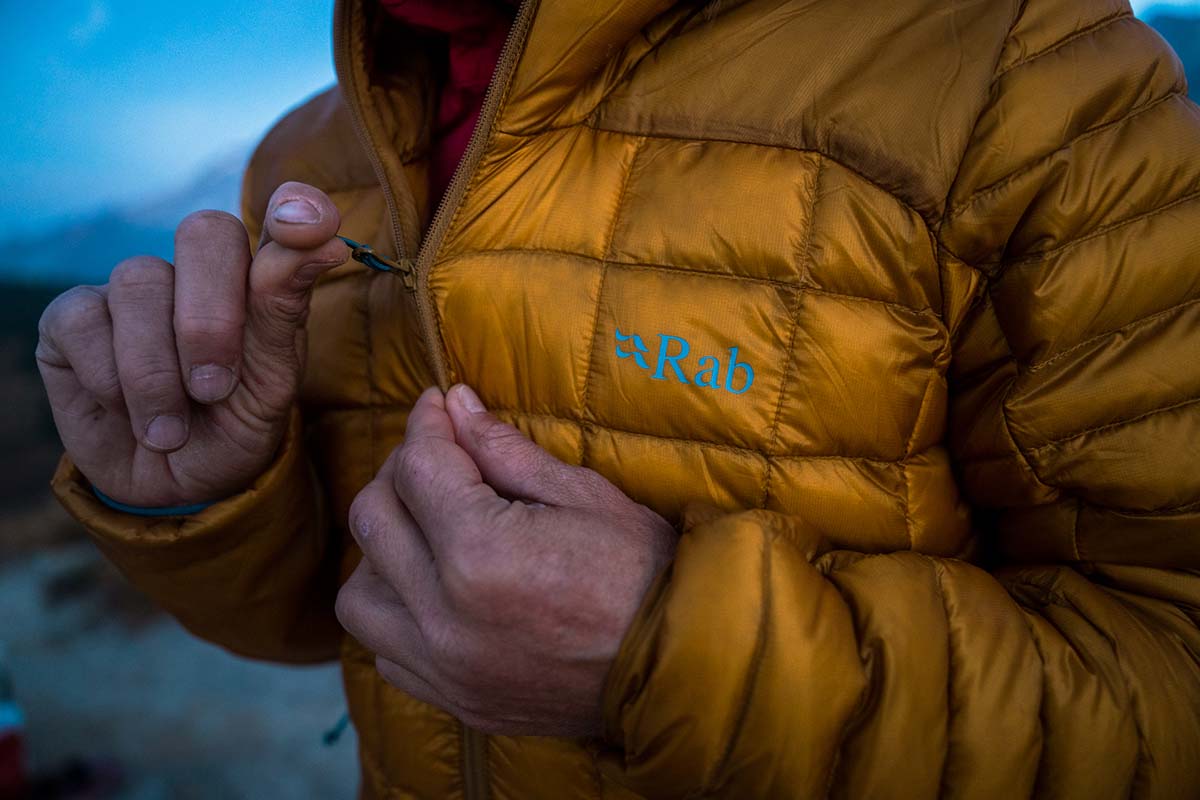
Down enthusiasts love its compressibility and for good reason. An ultralight jacket like the Arc'teryx Cerium Hoody can be stuffed into its own pocket and end up much smaller than a Nalgene bottle. The tiny packed size means you have little reason to leave it behind and can fit it easily into either a daypack or overnight backpacking pack.
Keep in mind that the higher the fill power, the more easily your jacket will compress. This is noticeable when you get into premium levels of down (800-fill and above), which pack down to seemingly impossible sizes yet bounce back after only a few minutes out of the bag (as long as you don’t store it compressed too long). Fabric thickness also plays an important role, and lower-denier fabrics logically pack down smaller. Along with warmth for the weight, compressibility is an area where down dominates the vast majority of synthetic-insulated jackets.
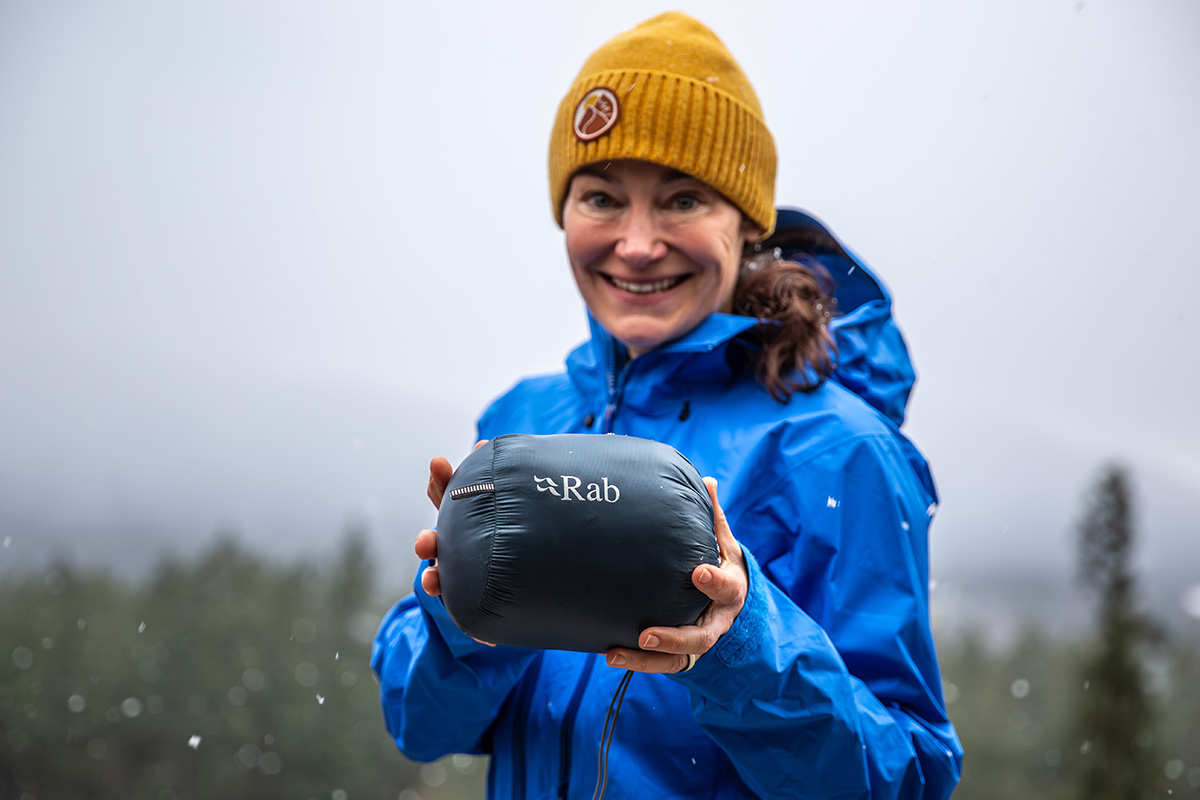
As the casing that holds the all-important down, a jacket’s shell fabric is a crucial component to consider. The thickness of a jacket’s outer fabric is listed in denier (D), which is a measurement of the weight of a thread. The lower the denier, the thinner the fabric. Thin shells are less durable and more susceptible to tears or punctures, but they’re also lighter-weight. That said, almost all of the jackets on this list are made with reasonably lightweight shell fabrics. The thinnest is 10-denier, found on ultralight options like the Rab Mythic Alpine Light and Mountain Hardwear Ghost Whisperer. The thickest (at least among those that report this spec) is the Outdoor Research Coze Down Parka, which has a robust 70- by 90-denier shell. 10 denier is fairly standard for ultralight pieces, and a more substantial 20 denier is what you’ll find most often in an average down sweater. Don’t underestimate the impact of denier: Even the difference from 10 to 20 denier can play a significant role in the total weight and potential lifespan of your jacket.
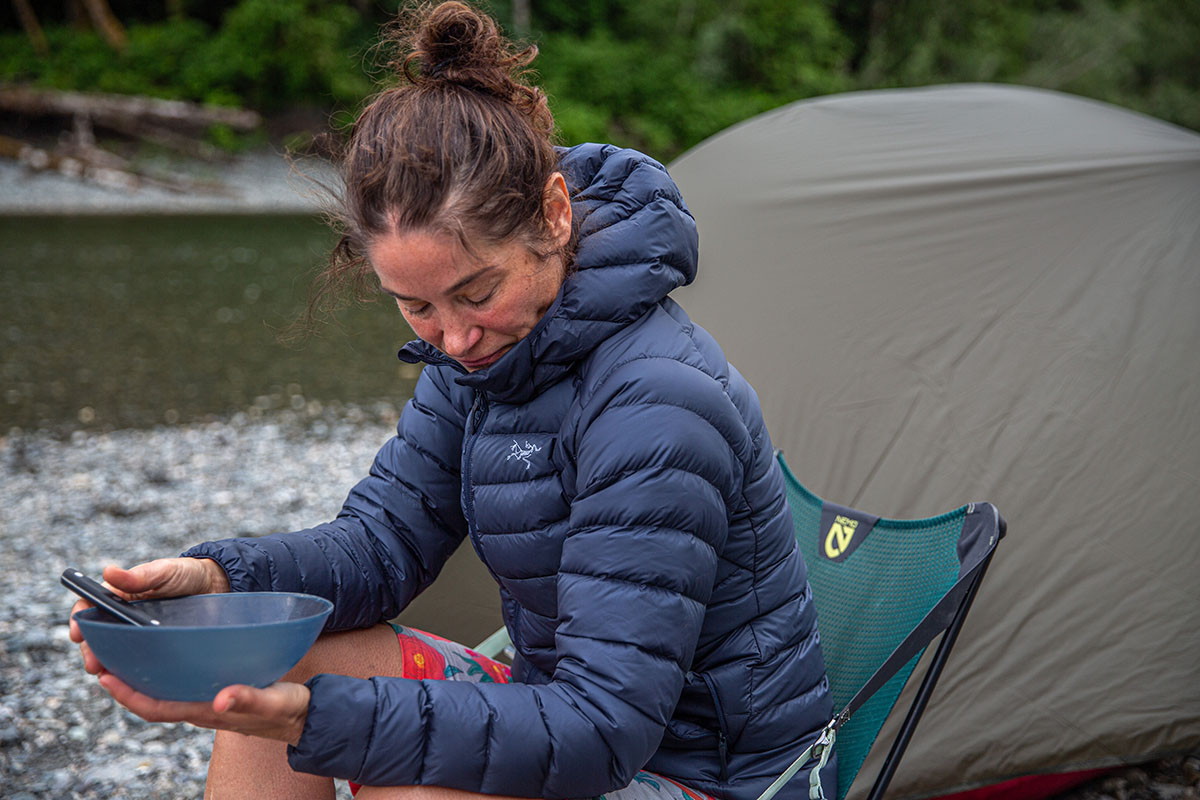
Other than denier, there are a few other factors that impact the overall durability of your jacket’s shell. First, a fabric with stretch, like the Mountain Hardwear Stretchdown, will have a lot more give to it, meaning it will stretch under pressure rather than rip. Very few down jackets are made with stretchy shell fabrics, but we like Mountain Hardwear's innovations here. Another consideration is the material. For example, we find the difference between the Pertex Quantum Pro and regular Pertex Quantum to be palpable (the former is much more durable). Finally, some jackets will use higher-denier fabrics in high-use areas such as the sleeves and shoulders, which can make a huge difference. To summarize: If durability is one of your top priorities, you’ll want to dig a little deeper than the initial denier spec.
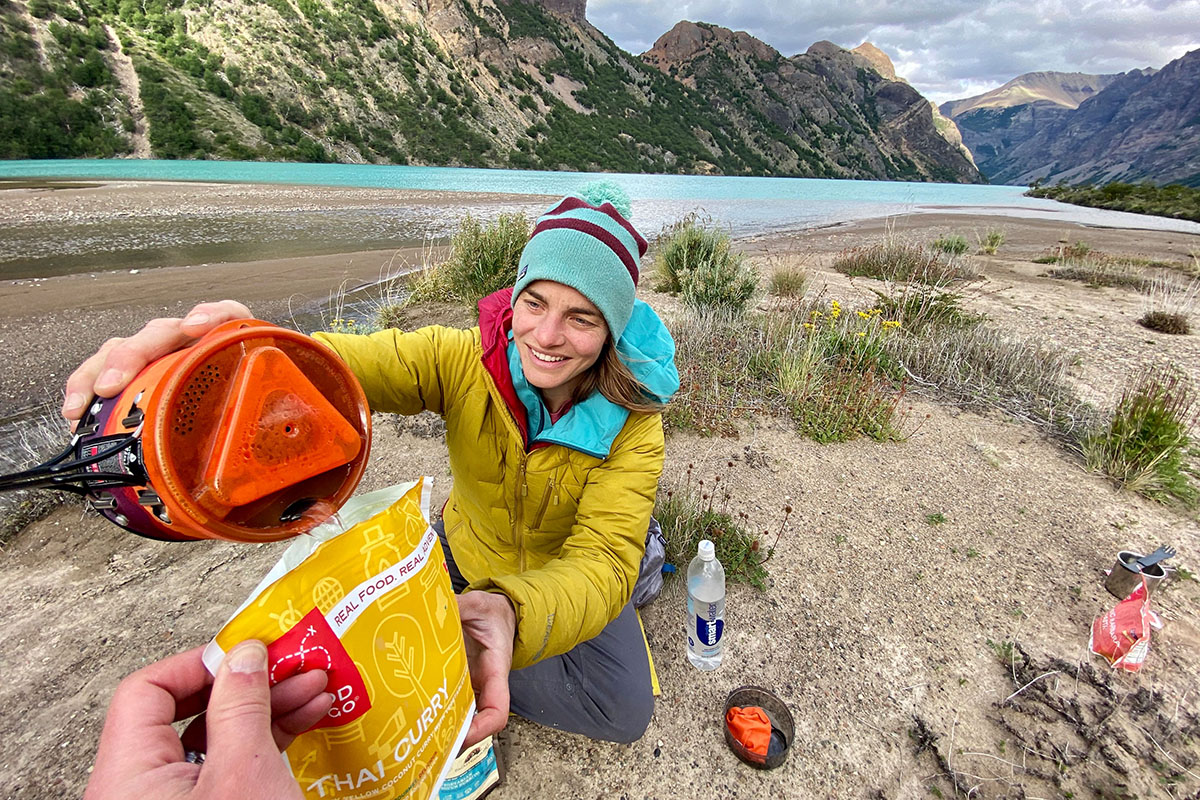
Down feathers unfortunately lose much of their ability to insulate when wet, turning into a clumpy and soggy mess. This makes them a serious liability in wet conditions or if you’re sweating heavily, which is why some folks prefer synthetic jackets, which continue to insulate when wet. However, gear manufacturers have found a way to treat down to make it more water-resistant. They do this by adding a polymer to the down before filling the jacket, and the result is that it resists water better and you don’t have to worry as much about light precipitation. Even though hydrophobic down still doesn’t match the wet-weather performance of synthetics, it can be an extra line of defense. If you’re headed out in a wet area like the Pacific Northwest or New Zealand, a jacket with hydrophobic down like the Black Diamond Approach (along with a waterproof shell) is a smart choice.
Another way gear manufacturers fight moisture is by incorporating synthetic fill in moisture-prone areas. Five of the jackets on our list above feature this type of “hybrid” construction: the Arc’teryx Cerium, Rab Mythic Alpine Light, Himali Accelerator, Outdoor Research Coldfront, and Fjallraven Expedition Pack Down Hoodie. Compared to down, synthetic insulation is less warm, heavier, and less compressible but doesn’t lose its loft when wet. This means it will continue insulating even when soaked. Given their more specialized builds, you can expect to pay a premium for jackets that use both types of fill (the Coldfront is the best value of the bunch at $279), but the added wet-weather assurance could be well worth it depending on your objectives. And if you’re debating opting for a jacket that’s insulated exclusively with synthetic fill, we cover a couple of our favorites in the section on synthetic jackets below.
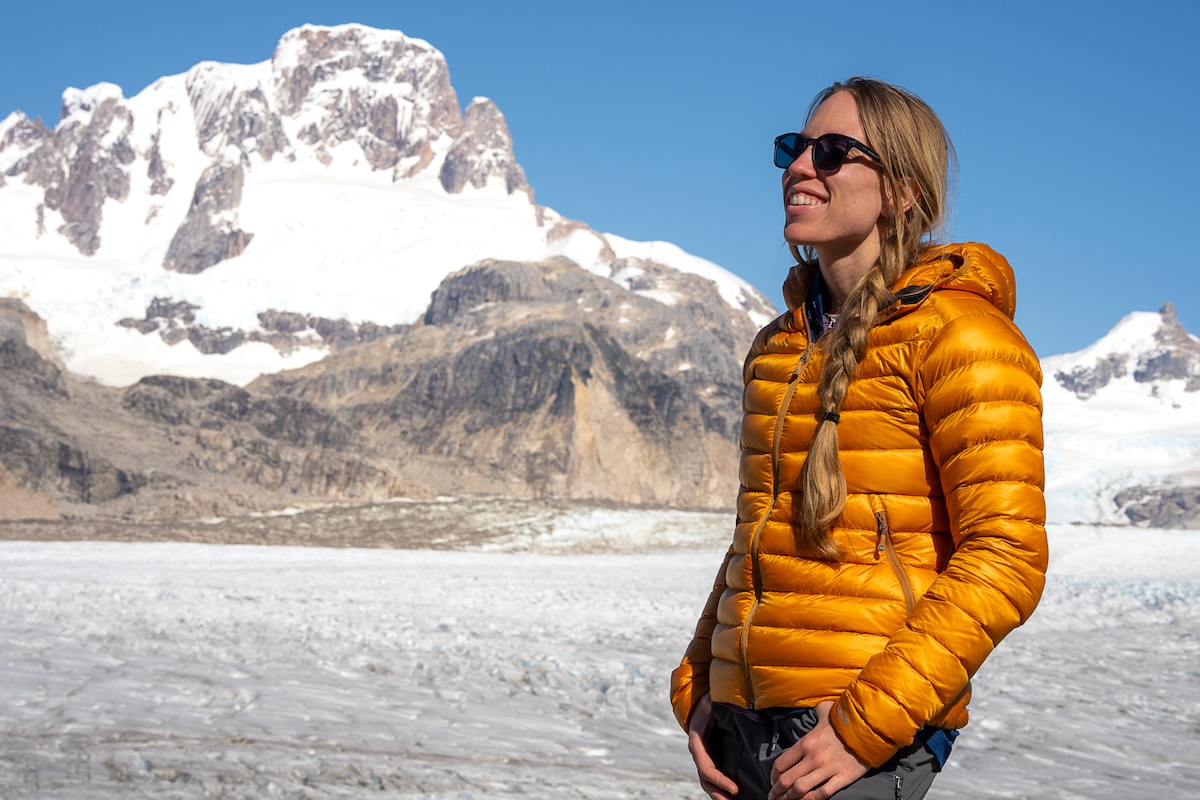
A final—and very common—line of defense against moisture is a DWR (short for durable water-repellent) treatment on the outside of the jacket. This coating causes water to bead up and roll off the shell fabric rather than soaking through. But while a DWR finish provides a nice line of defense for short bouts of light rain, it's easily overwhelmed in sustained moisture. For full protection against wet weather, you'll want a rain jacket or hardshell over your down jacket.
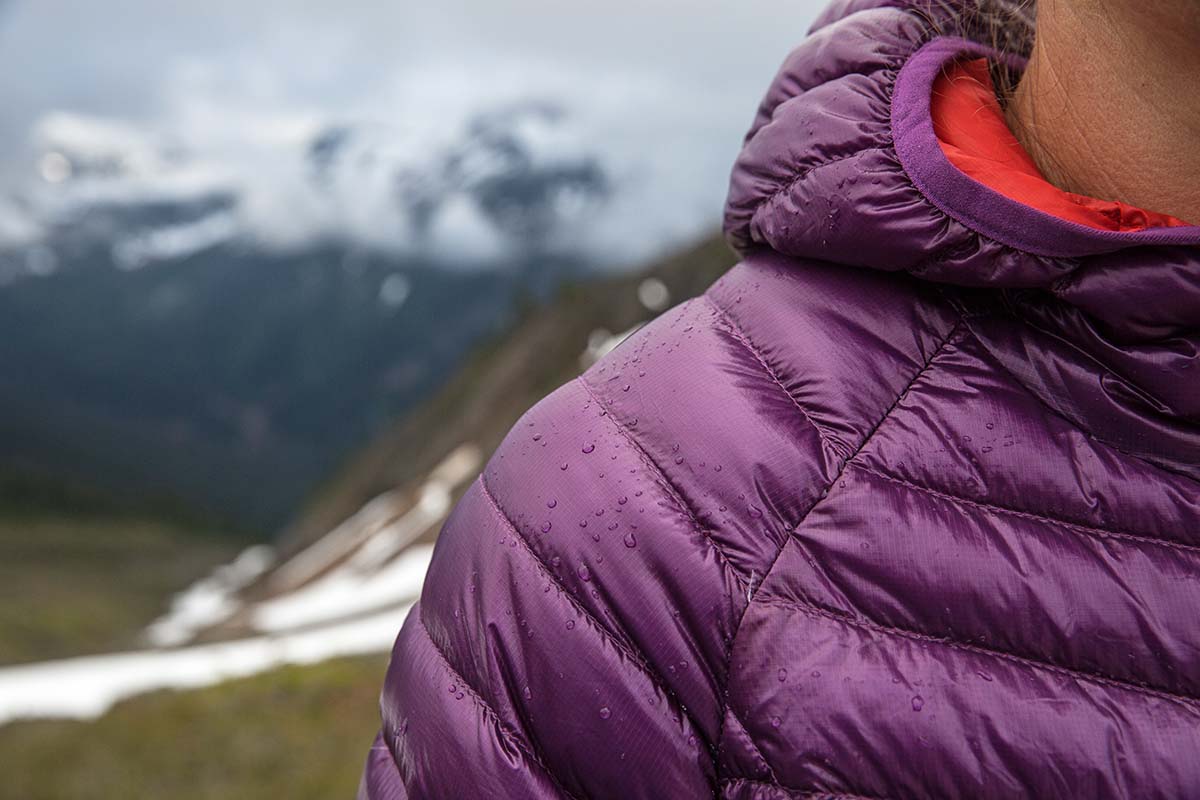
Fit is jacket-specific, but there are two main considerations here. First, casual jackets and down sweaters generally have a more casual fit than ultralight or performance jackets, including boxier torsos, arms, and hoods (when available). Second, fit varies significantly by brand. From our experience, Arc’teryx jackets like the Cerium Hoody have a slimmer fit and are a good match for athletic folks who demand mobility from their jackets (this can also be good for layering under a shell). Norrøna and Rab also err on the trimmer side, while brands like Patagonia, Outdoor Research, and Mountain Hardwear often have more accommodating shapes that balance everyday comfort with performance. And finally, we’ve found that REI Co-op and Cotopaxi fall on the roomier end of the spectrum, and we occasionally need to size down (including with the REI Co-op 650 Down Jacket).
.jpg)
You’ll also want to take length into account with your down jacket purchase. Simply put, a longer cut equates to more coverage and warmth, although it does have some impact on mobility. On the shorter end of the spectrum, many down sweaters and other lightweight pieces end right around the waist or hips. This is great for movement, but your legs remain uninsulated. A number of down parkas like the Marmot Montreal offer thigh-length coverage, which offers a nice boost in warmth compared to the down sweater counterparts. And models like the Patagonia Down With It Parka or OR Coze Down Parka go all the way to the knees, which is excellent for staying cozy when it's really frigid.
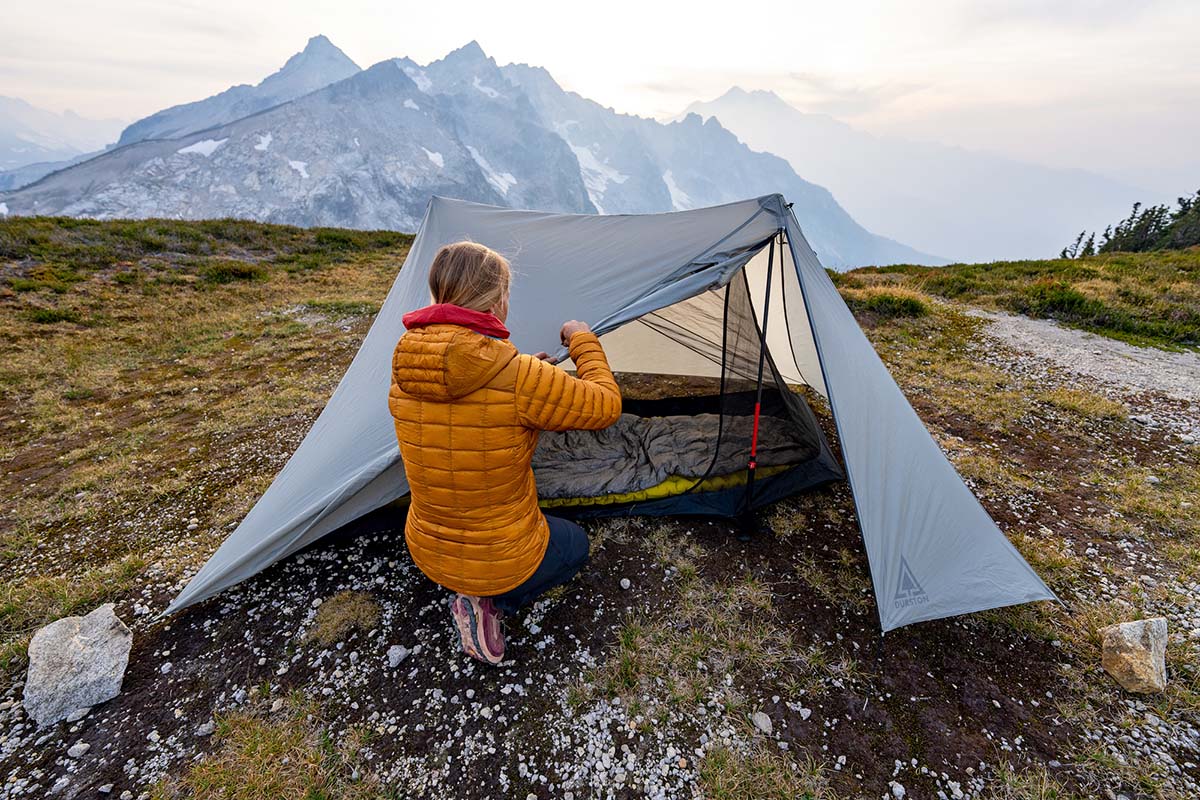
Many down jackets on this list are offered in hooded and non-hooded versions. The non-hooded version is slightly cheaper and weighs less, but you don’t get the advantage of the extra warmth, coverage, or comfort from a hood. For casual use or as a midlayer for skiing, many go without the hood and carry a separate beanie instead. For uses like backpacking and climbing, the opposite is the case: Most pay extra for a hood and don’t regret it. Ultimately, it all comes down to intended use and how you plan to layer for your preferred activities. For a deeper dive into the topic, see our article: Does Your Down Jacket Need a Hood?
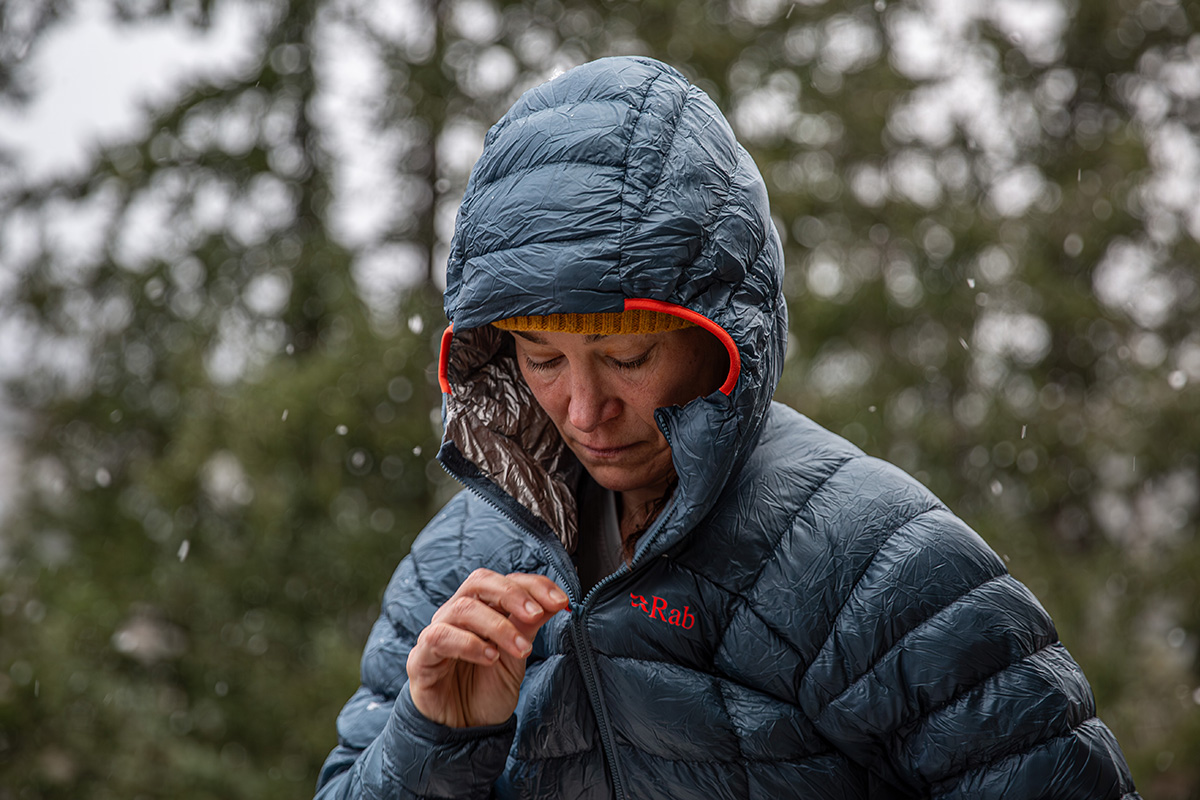
Our impact on the environment has never been of greater concern, and it’s nice to see gear companies step it up with more sustainable practices. One measure we’re seeing more and more of is the use of responsibly sourced down (look for an RDS certification or, in the case of Patagonia, Advanced Global Traceable Down). In short, this translates to greater transparency in where the down comes from and ensures the birds were treated humanely and not subjected to unnecessary harm, such as force-feeding or live-plucking. In addition, the use of recycled fabrics has grown substantially in the past few years, with companies like Patagonia, REI Co-op, and Mountain Hardwear prioritizing these materials.

A final trend to touch on is the use of PFAS-free durable water-repellent (DWR) finishes. We detail the benefits of DWR above, but pertaining to sustainability, traditional DWRs utilize perfluorinated compounds (PFAS), which is a chemical that’s been linked to a range of environmental and health issues. The good news is that some brands have started making the shift to PFAS-free DWR, but it's mostly been limited to the rain jacket and hardshell markets (Marmot and Mountain Hardwear are leaders here). That said, given the current landscape, we fully expect this to be incorporated into the down jacket world in the next few years.
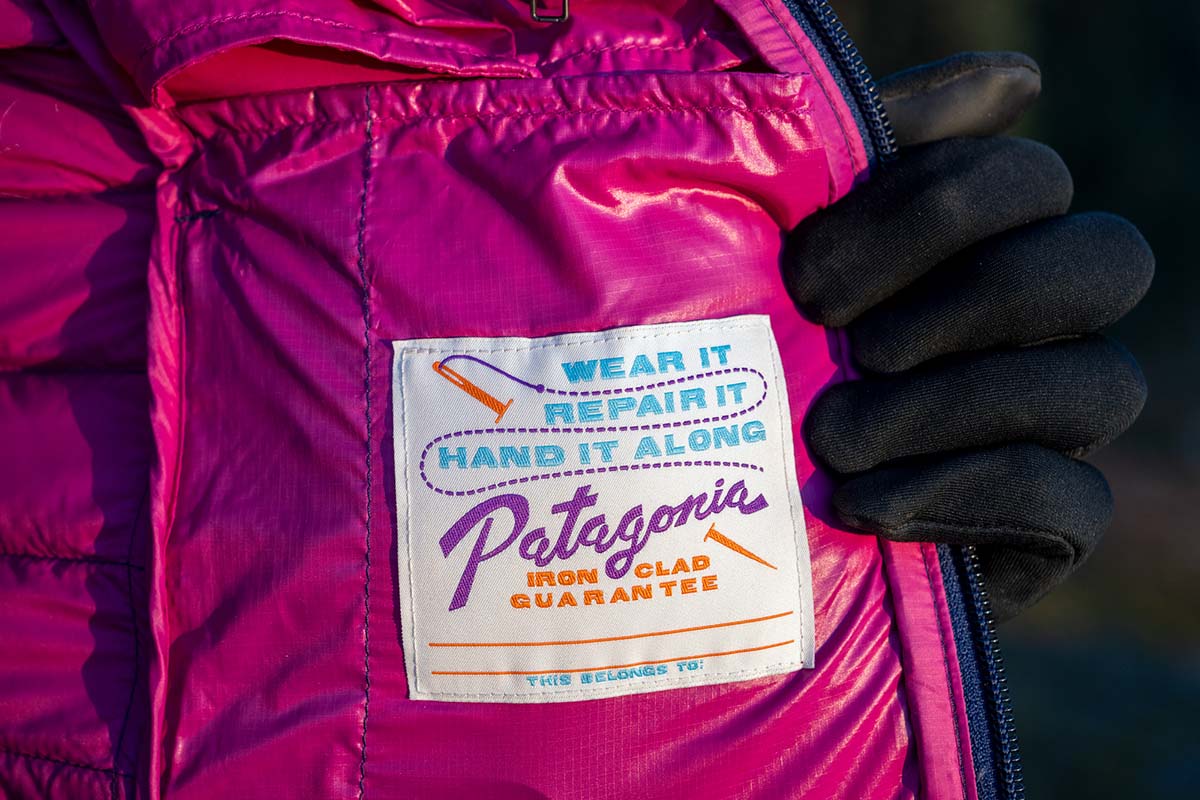
There is a lot to be said for synthetic insulated jackets, which insulate better than down when wet, are more breathable, and generally cost considerably less. For insulation that we wear during activity (such as while climbing or backcountry skiing), we’ll reach for synthetic over down nine times out of 10. However, when it comes to particularly cold weather or weight- and space-conscious pursuits (when you’re carrying your jacket in your pack), down has no replacement (at least for now).
We’ve tested a number of synthetic jackets like the Arc’teryx Atom and Patagonia Micro Puff, both of which are very comfortable and reasonably light. However, the warmth-to-weight and packability just aren’t the same as down options, and there’s simply no substitute for the comfort that lofty plumage brings. Optimally, you would have both, but if you’re only in the market for a single jacket, there’s simply no better insulator than down. For a more detailed explanation of this topic, see our article on down vs. synthetic insulation.
Back to Women's Down Jacket Picks Back to Women's Down Jacket Comparison Table